Wednesday, 21 July 1999
Nuweiba, South Sinai, Egypt
Leaving Jordan by the ferry to Nuweiba in Egypt is a pretty chaotic affair. Step one is to pay departure tax which we were told to do upstairs in the terminal building but which in fact had to be done downstairs in an office just behind the guy who tells you to go upstairs. Step two is to get your exit stamp. This is in fact done upstairs in the terminal and involves waiting around while three sets of people leer at your passport. A Belgian girl in front of us was told that she had the wrong passport since the photo in it was of a boy. She did not take the joke well and they managed to wind her up. They started to try something with me but I grabbed the passport off them and walked off. Step three is to wait for hours. The ferry left an hour after the scheduled time which was quite good considering that we had been forewarned that two hours was the norm. The voyage lasted about three hours during which we had little to do but watch the odd dolphin playing in the wake of the ship and comment on how blue the Red Sea actually is. Finally we arrived and set foot on the Sinai peninsula.
In retrospect I think that the unusual lack of order at the Jordanian end of the ferry route is a good natured attempt by the Jordanians to prepare you in some way for the chaos at the other end. They had taken our passports from us as we boarded the boat but when we disembarked they were nowhere to be found. We were told to get out of the boat, we tried telling them that we were not getting off the boat without a passport but the rugby scrum of people trying to get off had other ideas. We gave up and let ourselves get carried out onto the dockside only to find that no-one there had the vaguest idea where they were. We found an official of the ship who told us that he would take us to the "security officer" who had them but we would have to wait. Anna understandably got a bit upset with this and the whole thing got a bit ugly, the officer exhibiting an ability to be sarcastic quite beyond anything we had seen in any other country except, of course, Britain. Finally he relented and took us and several other irate tourists over to a guy who was walking around the docks with a load of passports in a plastic bag. He told us that we could not have them yet. We begged him to at least let us see them so we knew they were safe the as soon as we saw them grabbed them and ran off.
Next we were all loaded into a bus and driven to a hanger. The hanger had some x-ray scanners in it so we assumed it was a customs hall except once our bags were scanned there was nowhere left to go. We all ended up sitting on tables bitching about the whole thing for about an hour until some magical turning point was reached and we were all released. Outside we found taxis waiting to take us into the town of Nuweiba and since by this time it was about nine we were so desperate to get away we mistakenly allowed ourselves to get ripped off by the taxi driver. We found a rather run-down sort of camp site by the sea which our guide book advised us was next to where the bus to St Catherine's left from, pitched our tent and went to get dinner at a restaurant called "Dr Shish Kebab". It was an amazingly chaotic day and the only bit of luck that we had was that the beach bar of our camp site served beer so we were able to have a quick nightcap by the side of the, by now, completely black Red Sea.
Thursday, 22 July 1999
Mount Sinai, South Sinai, Egypt
Opinions varied wildly as to whether there was a bus to St Catherine's any more. The best information we had was that there was not one but there was one from Dahab, the next town down the coast, and there was a bus to Dahab at six in the morning. Both of these bits of information proved to be wrong, we waited for half an hour for a bus and saw nothing. Eventually we panicked and flagged down a passing taxi which was taking an Israeli guy to Dahab.
It took a while but finally we arrived at Dahab's bus station. We went to the tiny ticket office and were told "No bus". It was pretty much the last straw, hundreds of taxi drivers were hanging around waiting to take us to St Catherine's for vast amounts of money and the few backpackers there were of no help. judging by their glazed expressions they could have only been of assistance to people wanting directions to the moon. We then lost more money getting into the centre of Dahab and watched the droves of goatee-bearded potheads trying to work out which way the beach was in desperation. It was looking like the only way would be to hire a taxi. We were rapidly getting upset with Egypt, we were used to Jordan where people ask you if you need any help if you so much as think that you are lost, and really do help you. Here the only person who offered to help us told us that mostly people left for St Catherine's and Mount Sinai at eleven at night and that if we wanted to wait at his hotel...
Eventually we found a minibus that was going back to Nuweiba and we arranged for the driver to drop us at the junction to St Catherine's which is roughly half way between the two. The other occupants of the bus were an American family of three who had just come from a three day camel safari to St Catherine's (which they had paid an incredible $600 for) and now were on their way back to Israel. The junction was more like a military check post and as we tumbled out of the minibus with our rucksacks the soldiers fingered their M-15s rather nervously. Although there was plenty of traffic nobody would stop, a coach did stop for us but when we got to the door they closed it in our face. The driver of a pick-up that stopped looked back at the soldiers and then told us no. Finally the officer in charge of the check post called me over and explained that "for our own safety" we were not allowed to ride in the back of trucks. I informed him that if we did not get a lift we would probably die of thirst so if he was really worried about our safety he should help us to get a lift with whatever the appropriate class of vehicle was. Eventually another minibus that had been hired by two Belgian girls stopped and their guide agreed to take us. Yet again we were so pissed off that we did not negotiate the price down.
We finally arrived at Saint Catherine's Monastery at eleven. The taxi rides had been such a drain on our cash supply that we decided we could not stay in the monastery rest house that night. It was a bit of a dumb decision because it turned out that there was a bank open. But instead we walked the three kilometres to a place which called itself a campsite but was in fact little more than a flat area. One benefit was that it cost virtually nothing and had some shade, the tattered remains of some bizarre circular structure. The tent pegs would not go more than half a centimetre into the solid ground and we ended up having to use rocks to keep it in place. Of course by the time we had done all this the monastery was closed (its hours were 0900 to 1200) and so we had little to do but hang around all day.
Hang around was exactly what we did do, sorting out the money situation, eating, having a siesta and then eating again. We broke up the cycle a bit by going to the monastery in the afternoon. I meant to take some pictures of the outside but forgot to which was stupid because when we saw it again it was in the shade. It was all a bit of a lost afternoon and the surrounding area did not help to cheer us up. We had visions of a quiet mountain village what we found was a half abandoned building site cum rubbish dump. I think either someone had big plans for the place or else they get a lot of visitors at Easter because there were several very big and very empty looking hotels scattered around. We went to bed cursing the fact that we had not stayed longer in Jordan and so arrived on a different day. It was Thursday and the monastery is closed on Friday. We had realised that this would happen but we thought that the surrounding area would be a great place to explore for a few days rather than being the lunar landscape of twisted rock and no vegetation that it actually was.
Friday, 23 July 1999
Mount Sinai, South Sinai, Egypt
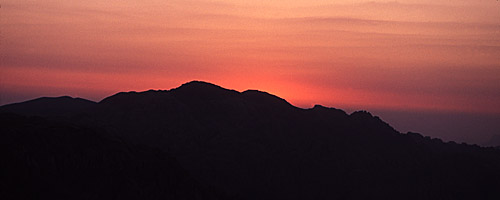
(Mount Sinai, South Sinai, Egypt)
Instead of walking we decided to spend the day working. I was quite a long way behind in my diary, besides which there did not seem to be anywhere you could walk to without the services of a guide. We had found a nice restaurant the night before and so returned there for breakfast, occupied a table then worked through to lunch. We attracted a bit of attention but it was not too hard to get on with things. After lunch we returned to the campsite, packed up then walked to the monastery.
On the steps of the rest house we found a guy waiting for the luggage store to be opened. His name was Dave and he was also planning to spend the night on Mount Sinai . Since we also had to wait for the store to be opened we got chatting to him and continued the conversation all the way up the mountain. He was American and sometime after having completed a history degree he decided to go to Israel to study Hebrew at a kibbutz. The strange thing was that he was not Jewish and had no intention of living in Israel. His reasons for embarking on such a course of action we never got to the bottom of, it was to do with studying ancient religious texts. He certainly had a very thorough approach to things, reading Lawrence's Seven Pillars of Wisdom whilst camel trekking in the desert of the Sinai for example. Anyway whatever his motivations he was quite illuminating on the subject of Israel. For example he told us about the Ultra-Orthodox Jews who, whilst being content to live in it, believe that Israel as a secular state has no right to exist and everything should be run on a purely religious basis. How Israelis are paranoid about being invaded and because of this never build anything properly because they think it will be bombed before the year is out. Whether or not this last nugget was true it certainly helped explain why the stage constructed for the 1999 Eurovision song contest looked like a "Here's one I made earlier" from Blue Peter.
It took about two hours but finally we reached the top of Mt Sinai. Fortunately we had a pretty good idea what to expect otherwise the site of two or three shops selling tea and renting ground mats may have been too much to bear. Dave did not look too crestfallen either but I suspect he was hiding it well. We sat on the top talking to him and a dutch couple plus guide who we had met coming up. Gradually other groups began to appear ranging from a group of singing, hiking Austrians to a group of French day trippers replete with Hilton lunch boxes. We managed to find a pretty great place to stay on the concrete roof of some building just below the chapel and then went to watch the sunset. Sitting there on top of the mountain with the orange glow of the dying sun and the silhouettes of the jagged mountains all about was a pretty unforgettable moment. It was also the only moment when the true colours of the place were allowed to shine through. The rest of the time we were there it struck me as no more than a grotesque tourist attraction.
Saturday, 24 July 1999
Naama Bay, South Sinai, Egypt
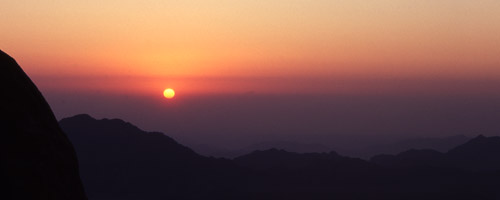
(Mount Sinai, South Sinai, Egypt)
It is difficult to explain why Mount Sinai draws people in such great numbers. Later on we were to stay in one of the Red Sea resorts and the conclusion I am forced to reach is that there is really a shortage of things to do for the thousands of tourists staying in the resorts and so Mount Sinai has become little more than an escape from the heat and repetition of life in a beach resort. If this seems a bit cynical then one only has to look at the two hundred plus people who climbed the mountain that day then shuffled around the monastery. The place meant nothing to the vast majority of them.
We woke up to find ourselves surrounded by people and cameras. The sunrise was not half as spectacular as the sunset and was not enhanced by the flashes of compact camera attempting to light mountains tens of kilometres away. Just below us a tour group were cooking breakfast. We roused ourselves, I took a few half hearted photographs and then we packed up. Walking back to the path down I saw something that summed the place up, a tourist had climbed on top of the roof of the shrine in order to take a picture of its cross with the sunrise in the background.
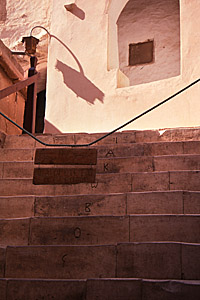
(St Catherines, South Sinai, Egypt)
Back down at the monastery the circus was in full swing. In reality we should have gone to visit the day before when it was officially closed but open to Greek Orthodox Visitors (i.e. Anna). Two hundred people all dressed in T-shirts were queued up and being issued smocks before shuffling in through the front gate. Once we got in we found that very little of the monastery was accessible to the public. Just a small courtyard with a tree descended from the burning bush, Moses' well and the chapel. Fortunately Anna came to the rescue and by chatting to one of the Greek monks managed to tag on the back of a select group of scholars who were being taken up to the library. The library at St Catherine's is one of the largest collections of religious texts outside the Vatican and can usually only be viewed with special permission. It was quite interesting as several texts were on display including a copy of the decree by Mohammed guaranteeing the monastery's safekeeping.
Back outside the monastery we retrieved our bags and said goodbye to Dave who was heading in the opposite way back to Israel. We had a bit of hassle trying to find a taxi to get us to Dahab but in the end we got there. The taxi driver dropped us at the bus station, herds of people descended on us to tell us that there was no bus to Sharm-El-Sheikh, we ignored them and sure enough found a bus leaving within half an hour. By four we were installed in a hotel in the scorchingly hot Na'ama bay and were wondering what to do with ourselves about half an hour after that.
Sunday, 25 July 1999
Naama Bay, South Sinai, Egypt
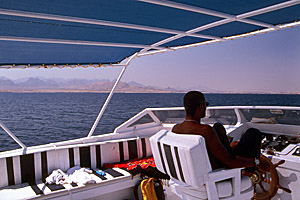
(Naama Bay, South Sinai, Egypt)
In a bit of a unusual move I have decided to depart from my usual day per day account in favour of one entry covering Na'ama bay. The reason for this is that this time was like a holiday within a holiday. The place had little to do with Egypt, or maybe a lot to do with modern Egypt but this is not what I want to write about it. More importantly it would be desperately boring to write a detailed account of the nine days and probably twice as boring to read. It is not that all our time there was boring its just that we spent most of it diving or recovering from diving. Instead I have decided to write a short bit about the place and a short bit about the diving.
Na'ama bay is a city built on coral. Not only are a few of the hotels built on the compacted remains of reefs that long ago rose out of the sea but also without them the place would not be worth coming to. If I imagine it without the hotels I guess it would be a bit like Paracas in Peru, a place where the desert hits the sea. Endless beaches, cliffs and blue sea. Take away the carefully manicured gardens of the Hilton, Marriott et al. and I think there would be not one single tree or bush. Under the water its a completely different story. The Red Sea is an almost enclosed body of water and so maintains a much higher temperature than the ocean. In this hot soup plankton flourishes as do the fish that feed on it, the sharks that feed on them and the coral gardens that they swim through. Look above the water and all you see is a golden strip of sand and mountains rising behind, look below and you see a riot of colour and life.
Sadly there are hotels and worse than this there are too many hotels. With a level of optimism rivaling that of office developers in London in the 80's they build new hotels day and night. From the sea Sharm-el-Sheikh seems like a vast city stretching 10km north and south of Na'ama bay. The truth is that its only a concrete and glass veneer, in very few places is the development more than one "Movenpick Jolie Ville" deep. Every chain is represented: Hilton, Mariott, Sheriton, Sofitel, Novotel... But perhaps the worst thing is the way they carve up the coast. In Na'ama itself the entire beach is divided up between the hotels each with its own design of towels so interlopers can easily be spotted. If you stay in the only (barely) budget hotel in town you do not officially get one square centimetre of beach, you have to beg, pay or sneak your way in. We went for option three on a couple of occasions and the second time got "moved on". Fortunately we had not come to the place for sunbathing.
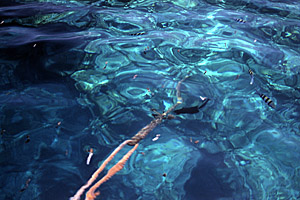
(Naama Bay, South Sinai, Egypt)
We went snorkeling on our second day there. We had learnt from Pulah Weh that most of the more spectacular of fish hide during the sunniest hours of the day. If you want to see a moray gliding between coral outcrops get to the reef before breakfast. In Na'ama this is doubly true because at quarter past nine a constant stream of dive boats zip through the waters of the Near Gardens (the most accessible reef for snorkeling) on their way to dive sites north of the bay. This procession culminates with the arrival of the glass bottomed boats you can't blame the fish for hiding. Anyway we got there early, saw lots of fish and prepared for the harrowing ordeal of equalising by doing the odd dive down to four of five metres.
Choosing a dive shop was pretty hard but we ended up choosing the one that had the best ratio of dive masters to clients. It worked out well because we were rarely in groups of more than six and once we had a dive master to ourselves. We started off diving at sites close to Na'ama bay and worked our way out to Ras Mohammed and the Tiran Straits. Ras Mohammed was particularly memorable. Being on the tip of the Sinai Peninsula currents hit it from three directions churning up food and attracting huge shoals of fish. The fish are not diver shy so you can literally swim through the middle of them. The most impressive were the dinner plate sized batfish, the friendliest the unicorn fish and the most elusive the barracuda. But fish and coral are not the only attraction of the reefs. The Yolanda, a boat carrying a cargo of bathroom supplies struck the reef a long time ago and although the boat itself has long since been sucked into the abyss the cargo is still littered around. Instructors have positioned a couple of toilets and amuse students by sitting on them. But even more surreal is a vast mountain of their porcelain bowls piled up to one side of the site. Perhaps even nicer than Ras Mohammed was Ras Ghuzlani a dive site that hardly anybody visits but which has superb coral and fish although, alas, no toilets. On our first day at Ras Mo. we did our second dive of the day here and found a very rare, very old and very big green turtle. It glided around with sickening ease nibbling away at the coral paying no attention to us whatsoever.
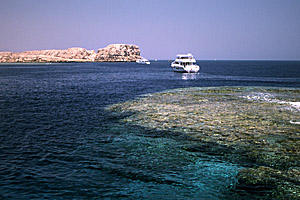
(Naama Bay, South Sinai, Egypt)
The Tiran straits also has more than its share of wrecks. In the straits is a chain of four reefs two of which have ships sitting on top of them. They are amazing sight the coral just below the water, the sandy turquoise lagoon in the centre and the rotting hulk of a ship perched to one side. On the way back we did a quick flyby of the most intact. Its hull had been eaten away by the salt water and it was now just resting on its huge engine block and propeller casing. Maybe in time it would all rot away and fall into the murky depths. The diving at the Tiran straits was not quite our style, too much worrying about currents meant that we could not really concentrate on the reef. I think that the place is more the haunt of shark spotters. We did not see a single shark but a Hawksbill turtle right at the end kept us happy on the "big things" front.
That's about all there is to say on the subject of our holiday within a holiday. We had very few problems apart from the extreme cost of everything and the lack of things to do out of the water. One amusing tale to round this entry off is that of our hotel's two hour long happy hour during which you got two beers for the price of one. We aimed on most days to be back for this and have a beer each and play cards or backgammon before going to bed. The thing was there was always a confusion over how many beers you actually wanted, people not in the know would order two beers an end up with four. I am not sure if it was the hotel's intention but on many occasions we watched customers trying to reason with the waiters that it would be a lot more pleasant to have the extra bottles resting in the fridge rather than on the table. Anyway it happened to us one night and we told them we had ordered only two beers. "Two for one, you order one you get two" they kept repeating. We replied "yes we know but we only wanted two", "yes but you get four for two" they replied. In the end I had to point out that we had been staying at the hotel for six days and were well aware of what two times two is so were unlikely to make a mistake. The unwanted bottles were the removed.
Thursday, 5 August 1999
Aswan, Egypt
Taking the train to Aswan had proved to be a bit of an ordeal. It was not our first choice - we should have caught the ferry from Sharm-el-Sheikh to Hurghada saving about fifteen hours of travel - but the most reliable person we could find had informed us that the ferry was not running due to lack of customers and we would have to go by bus via Cairo. We had done this on the fourth and at 2100 found ourselves in Cairo's Ramesses train station trying to get a ticket for the 2200 train. This is not a position I ever want to be in again. The train station has several ticket offices and you are directed to each one in turn before you finally get upset and are told that there are no seats. Not only are there no seats on the train leaving at ten but there are no seats for four days. The train station looks busy but it is hardly bursting at the seams. Anna to her credit did not believe them and kept pressing until someone admitted they had two returns. It was weird, although they had a computer system they did not bother to check it. We were just lucky that the two tickets were sitting in his office. At first he did not want to give us them because they were student tickets and he did not seem capable of giving us new tickets for the same seats. In the end the offer of a little extra baksheesh on the side got us the tickets.
Anyway that was basically it, we had bribed our way onto the train and only paid student prices. It made us sick to see there were spare seats in our carriage which were filled by rich Egyptians who would press a note into the palm of the carriage attendant. The other unusual thing about the train were the plainclothes policemen with Uzis guarding the carriage, but there you go. We survived a ticket inspection and trundled into Aswan at ten in the morning. To our surprise it was a fairly sleepy town and we had fairly little hassle on the way to the hotel. The New Abu Simbel Hotel was okay but within seconds of checking in we found out that the main attraction of Aswan, the temple at Abu Simbel was to all intents and purposes inaccessible as the road there was under repair. There was a plane but this was a very expensive option in light of the fact that you were just going to see one temple. We wandered around in a daze for a while double and triple checking what we had been told but in the end were forced to conclude that it was true.
We basically mellowed out for the rest of the day, the night in the train and the mid-forties temperatures making anything else impossible. That evening we ate in a restaurant floating on the Nile, the sunset proved as spectacular as the sunrise. On the way back we found a Nubian wedding in full swing and watched it a while from a distance. It was quite lively, one interesting thing was that whilst the men danced the women did not and in fact stood in a separate huddle off to one side. Whether this changed later on we never found out...
Friday, 6 August 1999
Aswan, Egypt
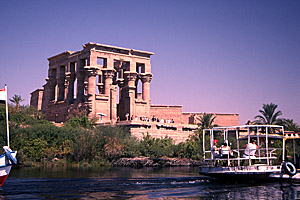
(Aswan, Egypt)
We left early and found a taxi driver to take us to Aswan's remaining sites. The high dam was first on the list. Its pretty spectacular when you think about it but when you look at it there's not much to see. Rather than being a 100m drop down a straight concrete wall the small lake between the dams was a the foot of a gently slope. The dam is a massive mound of earth and rock over the top of a concrete core and as a result if it were not for the regular shape and the Soviet inspired monuments on top of it then it would blend into the landscape.
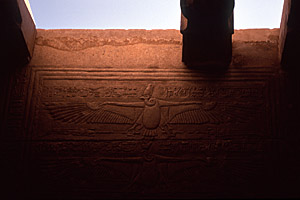
(Aswan, Egypt)
After this we were whisked to the motorboat quay serving the island of Philae . Here coach upon coach of tour groups was disgorging its contents into the fleet of boats and it was very easy to be overlooked. In the end we got together with a French family who had also arrived by taxi and then went through the indignity of haggling a motor boat driver down to the official price posted at the docks for the return trip. We phut-phutted over to the island cutting a course between several other islands. Rounding the corner we gasped with horror, the entire island was swarming with tour groups.
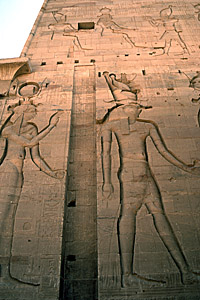
(Aswan, Egypt)
It turned out to be not the end of the world and apart from a couple of jams we managed to avoid most of the people. The temples of the island were made all the more amazing by the fact that they were rescued from a watery grave after the building of the high dam and were reassembled on an almost identical, but higher island. It was the first ancient Egyptian site we visited and I was immediately impressed by the huge bas relief carvings of people and the lines and lines of carved hieroglyphics filling virtually every centimetre of wall. The pillars too were a breath of fresh air. After weeks of intricate Greek and Roman efforts we were faced with massive chunky columns topped with capitals of a fairly bold design. We had pre-arranged when the boat would pick us up so we could not spend as long there as we would like but we saw most of it.
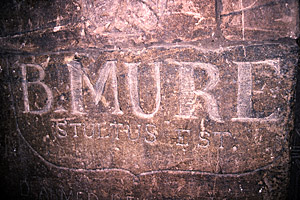
(Aswan, Egypt)
Just before we got onto dry land something very strange happened. The pilot of the boat started muttering something about baksheesh and tips and seemed to be trying to tell us how much tip we would give him. We found this very unpleasant and in the end gave him half what he asked for (which was still ten percent) and walked off. We found our taxi driver who started muttering something about us being late despite having lied to us about how long the boat would take to get to the island but we were not in the mood. On the way back to town we decided that the driver was a nice friendly chap and that we would give him a tip. The price of the tour we had haggled down to the government rate of E£20 and when we got back we gave him this plus 10% on top. He looked at what we had given him in disbelief, "give me five pound baksheesh!" was his response. Anna was amazed, she started giving him a lecture but he still persisted. I think we should have taken back the entire tip but in the end Anna gave him five pound in disgust and walked off.
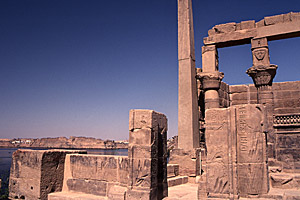
(Aswan, Egypt)
Things did not get better that afternoon. We had decided to run for the cover of Kitchener's island, a botanical garden on one of the many islands in the Nile opposite Aswan. We did not want to hire someone especially to take us there because that would mean staying there a fixed amount of time and paying by the hour. Someone told us that instead we could go there via one of the other islands. We got to the first island with no problem taking a Fellucca ferry and paying hardly anything but probably paying double. We then walked through a tiny Nubian village to the other side and found a guy waiting for the next ferry. When this turned up it was a rowing boat and as we rowed over to the other side I got to thinking how much easier it was to use local transport than hiring taxis etc. Of course I thought to soon, when we got to the other side the guy who I thought was just a passenger turned out to be the owner of the boat and turned out to want E£5 for getting us across. He had told us that it was a ferry beforehand but now the story was that there was no ferry. Yet again disgusted I reverse haggled the price down a bit on the grounds that if he was going to be unreasonable we would not go back with him (which we of course did not, preferring to swim than see his toothless face again).
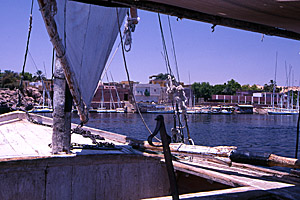
(Aswan, Egypt)
The gardens themselves were well kept and proved a very effective way of keeping out of the heat. We read the paper and relaxed accompanied by half of Aswan who had also run for the cover of the island on their Friday day off. On the way back we found that there were tons of boats hanging around at the other end of the island and we managed to jump on one with a group of Egyptian tourists thus avoiding the long swim.
Saturday, 7 August 1999
Luxor, Aswan, Egypt
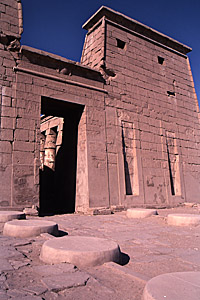
(Luxor, Aswan, Egypt)
The tourist train back to Luxor left at 0500 and we thankfully were on it. We had debated various options such as a four day felucca trip back up the river and a taxi stopping off at all the temples en route. However the taxi was too expensive and the thought of being trapped for four days on a sailing boat with a baksheesh hungry captain had lost its appeal after our experiences the day before. So it was back to the tried and tested state run train. We got into Luxor about ten, cut through the swathes of touts and found what seemed like a decent hotel. The manager gave us a cup of tea and sat down with us to tell us about the magnificent dawn donkey trip to the Valley of the Kings that he runs. We listened but told him we would think about it, which was true since we thought that it was pretty much the only way to get to the Valley at a reasonable hour.
Aswan has a laid back and quite pleasant atmosphere. In comparison Luxor is a nightmare, people try to sell you something every second you are there. The shouts of "caleche?", "taxi?", "felucca?", "baksheesh?" etc. do not stop for one minute and you always seem to be running away from someone. We had a quick lunch, checked out the local tourist office and then ran back to the hotel. We had decided to ignore all advice about the heat and walk around the temple at Karnak in the supposedly tourist free mid-afternoon. As we were leaving the hotel the manager accosted us again and started going on about the donkey trip. I said it sounded okay but at E£65 each we could not afford it (which was true because our daily budget was around E£180). He told me that this was the price, and he could not do it cheaper because of guides etc. We went on for a while and I gradually used up all my ammo, pointing out that the price for his trip in my guidebook was E£30, I could hire a donkey for E£15, we did not need or want a guide etc. He dropped it to E£45 but this was still way too expensive and he was making out that it would be as a personal favour to me, blah, blah, blah. Suddenly he got psychotically upset and wheeled around and went back in the hotel, locking the doors on us. Eventually he came out again and was totally rude - "there is no donkey for you!". I heard of similar things happening in India where budget hotels lost money on their rooms in the hope of making it back on tours. People who do not go for the tours suddenly find the management turning on them, their stuff chucked out on the street etc. We decided it was not that serious and headed off towards Karnak.
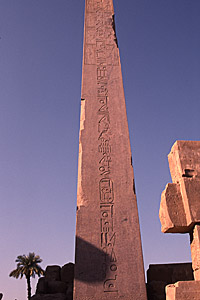
(Luxor, Aswan, Egypt)
The Temple of Karnak was as it turned out relatively deserted. Again the bas relief depictions of various kings, victories over their enemies and offerings to gods were stunning. The most unforgettable bit of the temple is the Great Hypostyle Hall, a huge array of gigantic columns 6000 square metres in area which you can wander around for ages. There are several massive obelisks and worn colossi dotted around the place and even a huge scarab beetle. We explored for a while, collapsed from the heat in the cafe for nearly two hours then explored a bit more taking some photos in the slightly better light conditions around six. One new development was that the site attendants had a very annoying technique to attempt to get baksheesh from you. They would hang around the entrance to a smaller temple or chamber and then ask you if you want to see it. They would take you in removing crude temporary barriers and grunting a few words like "Amun" whilst waggling a finger at nothing in particular. On the way out you would then find the previously friendly attendant with his hand out saying "Baksheesh". It was all rather transparent, especially as they picked on individuals and ignored tour groups. We were not fooled but it was annoying because whenever you wanted to explore anything you would find one of these attendants trying to "assist" you whether you liked it or not. The only time we failed to evade them we just ignored the guy and pushed past him when he asked for money. It was sad because without them it would have been a very explorable place.
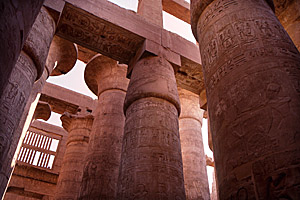
(Luxor, Aswan, Egypt)
Back at the hotel our luggage was still in our room so we decided that we would stay the night and move out the next morning. We had been read our guide book a bit more thoroughly and realised we could escape to a hotel in the fields of the west bank of the Nile and in fact be much closer to all the tombs of the Theban Necropolis. Our reading had also alerted us to the fact that there was an English pub in town. As usual it served the same beer as everywhere else but it did do a passable sausage and mash. It was a bit sad but to our critics we would say just try a diet of Shish Taouk, kebabs and falafel for two months and then you will understand!!
Sunday, 8 August 1999
Thebes, Aswan, Egypt
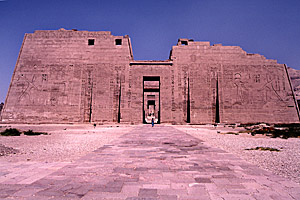
(Thebes, Aswan, Egypt)
Moving to the west bank was probably the best decision we made since we left Sinai. We found the public ferry and on the other side haggled with a taxi driver for a lift to the hotel. At first we thought we had been taken to the wrong place, there was no sign and no-one around. However by the time we had walked through into its courtyard shaded by huge palm trees, found Mohammed the manager and taken a small but airy room we were in love with the place. From the back you could look out over fields dotted with palm trees. From the front you could look at the barren Theban hills and the small villages nestling at their feet. We found out later that an hour's climb over the hills would take us into the Valley of the Kings and ten minutes walk in either direction would take us to the remains of huge mortuary temples. In fact the hotel was built on the site of the mortuary temple of Ameophs III of which only two colossi (the so called colossi of Memnon) remain stranded in the middle of a field.
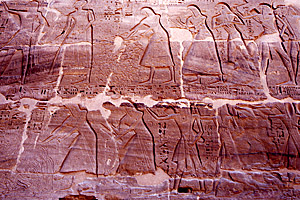
(Thebes, Aswan, Egypt)
It was still pretty early so we decided to head for Medinet Habu , the Arabic name for the mortuary temple of Ramesses III. As I already said it is barely ten minutes up the road from the hotel and through a great stroke of luck the central ticket office, which sells tickets for every site, is on the way. It is an amazing place, its huge first pylon and the attached wall are for the most part intact and it looms over the surrounding countryside like a prototype of the Battersea power station. There all comparisons must stop however because unlike the later its exterior is carved with epic scenes. Everywhere Ramesses vanquishes his enemies at sea as well as on land. Inside there is even a gruesome carving showing the piles of hands and penises cut from his dead adversaries. This is one of the major themes of Egyptian relief panels. The day before in Karnak we had seen panels depicting row upon row of bound prisoners each bearing a cartouche of a defeated tribe's name. The Pharaoh's clearly liked to wax lyrical about their prowess in battle and were not above exaggeration recording draws as victories.
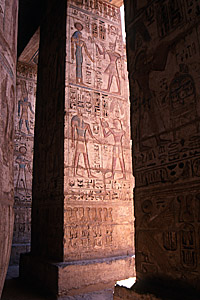
(Thebes, Aswan, Egypt)
The first two courtyards of Medinet Habu are in an excellent state of preservation. Whilst the first held a small village the second was turned into a Coptic cathedral at one point and its pagan murals covered by a coating of mud. When this mud was removed the murals were found in an excellent state of preservation and a lot of them preserve their (original?) colouring. They record festivals and depict Ramesses making offerings to the gods. We had seen traces of colour at Karnak but it had looked a bit like a restoration effort. In Medinet Habu we began to realise how colourful the monuments of the Pharaoh's once were. Beyond the second courtyard the inner sanctums were a bit more of a jumble but we were able to poke around in a few of the shrines and stare at more bas relief murals and texts.
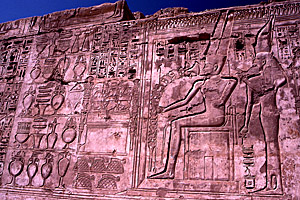
(Thebes, Aswan, Egypt)
By about eleven it had started to get unpleasantly hot so we returned to the hotel to recover. We had decided to stay for a few days so that Anna could get some work done since the hotel had quite a peaceful environment. This meant that we could adopt a more relaxed approach to sight seeing, limiting our excursions to the cool of the morning. Before we relaxed however we had to run one last errand, to book our train tickets days in advance to avoid getting into difficulties when the time came to leave. So for the second time that day we crossed the Nile and found ourselves in the seventh layer of hell aka Luxor. The pestering started straight away. At the train station we had the usual shouting match with the ticket seller who at first tried to claim that there were no tickets and needed quite a lot of coercing before we actually looked at his computer and saw that there were plenty of seats. We even ran into a bewildered South Korean couple who we had first met trying to get tickets in Cairo. They were again attempting to get out the same day. It struck me how unusual they must find a country like Egypt in comparison to those of Asia. Anyway we got tickets, checked our e-mail and did a bit of shopping before returning to the oasis of our hotel.
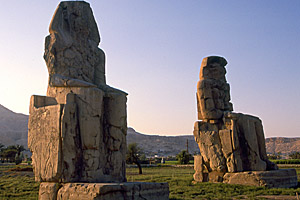
(Thebes, Aswan, Egypt)
We went for a short walk just before sunset to the Colossi of Memnon just behind the hotel. Not much of their details remain but nevertheless at 18m tall they are still very imposing. They apparently got linked with Agamemnon because it was believed that Agamemnon's father was an Egyptian king. One of the statues was fractured by an earthquake in 27 BC and the sound of the wind reverberating in the crack first thing in the morning was said to be the sigh of Agamemnon as he greeted his mother Eos, the dawn. What is probably the most thought provoking aspect of this tale is that the Greeks visited Thebes as tourists as well. In the Valley of the Kings you can see their graffiti carved into the walls of the tombs. It seems to us impossible that the Greeks and Romans could have been tourists just like us but the truth is that the Pyramids pre-date Greek monuments such as the Parthenon by two millennia!
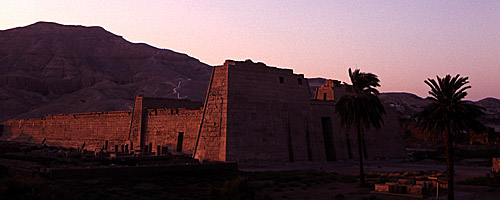
(Thebes, Aswan, Egypt)
Walking back from the colossi we found a beautiful clearing in a field of tall feather-eared grass where a few blocks of the former temple had at some time been uncovered but were now being reclaimed by nature. I was about to take a photograph when someone ran towards us waving his stick and shouting. Stupidly I did not take the picture and when he came over he started repeating "finish, finish all close". We attempted to reason with him pointing out that a couple of stones in a field ten metres from the main road could hardly be considered to have opening hours but he would not budge. He looked very nervous and this made we wonder if he was doing the whole thing for baksheesh, a sort of photographic blackmail. Anyway he was not going to get anything and eventually we walked off proclaiming that we were off to find the tourist police. Of course we were not, the only other thing we did that night was to climb a small earth mound in order to take a sunset picture of Medinet Habu.
Monday, 9 August 1999
Thebes, Aswan, Egypt
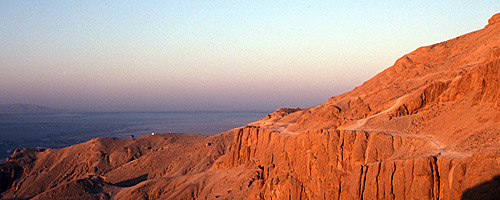
(Thebes, Aswan, Egypt)
It may seem a trifle crazy to get up at 0500 and set off in the dark up a mountain but in fact it is about the only time of day cool enough to contemplate such exercise. We had ruled out a donkey ride long ago and simply the thought of hiring a taxi for the day and the haggling ad baksheesh this would involve was even more tiring than the thought of getting up at this hour. We had rough instructions from the staff of the hotel and at about 0530 we stumbled out into the road under the light of a very waning moon. We followed our instructions which took us to the workers' village Deir-el-Medina and from there up a flight of concrete stairs constructed on the mountain to combat path erosion. About half way up the disc of the sun rose above the horizon. It was an unforgettable sight, the green carpet of the Nile flood plain wreathed in mist, the Nile snaking into the distance and seemingly appearing out of it the red fiery orb of the sun. It was instantly obvious why the Ancient Egyptians worshipped the sun and why also they believed it was transported in a boat across the skies. In fact it was a wonder that they bothered to invent as many other gods as they did.
At the top of the staircase the path turned to follow the top of the bluff of rocks which continues all the way along to the often pictured Hatshepsut's temple. Before this however we looped back over a low saddle into the Valley of the Kings itself. I would not describe the first sighting of it awe inspiring. For one it is pretty ordinary looking and then on top of this it has been so comprehensively paved that from above it looks like the road network of an industrial estate. We descended via a pile of rubble that had a rough path zig zagging down it and hopped over a low wall onto the nearest path.
Fortunately the Valley is the one place where they have their own ticket office and so we bought a three tomb ticket and sat down to figure out which of the sixty odd tombs we should visit. First on my list was Amenophis II. We had the floor layouts of several of the tombs in our guide book and to me anything with "pit" and "false burial chamber" was a must. To be honest when we found the tomb and worked our way down through the narrow sloping corridors and chambers the defences seemed a little lame. I was expecting a labyrinth of traps and devices "Tomb Raider" style complete with the skeletons of unsuccessful grave robbers. However when you finally stumble into the burial chamber of Amenophis II's tomb the sense of discovery is undeniable (especially if you are fortunate to get there before an Italian tour group). The colour is the first thing that grabs you, instead of being dark and claustrophobic the burial chamber is painted white with a ceiling of blue covered with golden stars. Onto the white background has been painted in simple black and red figures and hieroglyphs the entire Book of Amduat ("That Which is in the Underworld") which in places is like a map depicting the various ramps and corridors used to navigate the underworld. The usual pantheon of gods are depicted feeding Ankhs to Amenophis but here their hawk and ibis heads seem less comical. But the real gem in this tomb is the quartzite sarcophagus which is still in place and in fact still contained a mummy when it was discovered. Eventually a tour group did turn up and that "just broken into the burial chamber" atmosphere fell to pieces. However I will find it hard to forget that first tomb despite visiting many more elaborate and grander ones after it.
Next up was that of Merneptah a more typical tomb in that it descends in a straight and gently sloping series of corridors. Here the decoration of the corridor was a lot more ornate, each section containing spells of some sort or depictions of a funerary scene. You can see in the tombs of the valley a sort of chronological progression from the very clear cut stick drawings of the tombs of Amenophis II and Tuthmosis III to the increasingly more ornate bas relief scenes and books in the Ramesses ' and Setis' tombs. The other thing which shows a progression is the size of the sarcophagus. The very ornate quartzite affair of Amenophis II is replaced 200 years later in the tomb of Merneptah by a monstrous granite affair of two layers. Fantastically the outer sarcophagus has been towed to a separate chamber by mentally challenge grave robbers and the inner, human shaped one left in its original position. The inner sarcophagus looks like a prop from Fritz Lang's Metropolis and you can climb up inside it to see that on the inside the sky goddess Nut has been carved so that her arms wrap the mummy as she carries the soul to heaven.
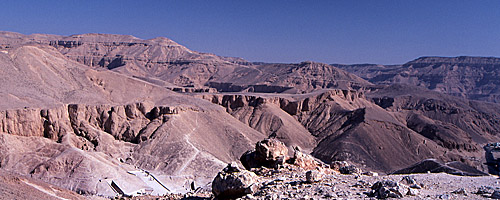
(Thebes, Aswan, Egypt)
It must be pointed out that by this time the number of people in the Valley had reached unmanageable proportions and although we had managed to avoid most of the groups so far it was clear this luck could not continue forever. So we decided to take the bull by the horns and visit the Tomb of Ramesses VI - another tourist attraction of the ancient Greeks who carved their graffiti into its walls. The crush of tourists inside was pretty unbearable, especially as all the tombs slope down into the rock and so get progressively stuffier and hotter. The decoration of the tomb however was very impressive and the various Books and other scenes were well executed. The most breath taking sight is the roof of the burial chamber. Here the Book of the Day and the Book of the Night have been executed literally back to back as each illustration is framed by the body of a sky goddess. The books were painted in yellow on a dark blue background so that the barrel vaulted ceiling of the burial chamber resembled the heavens themselves. Sadly the sarcophagus itself had been blown apart by treasure hunters but the immense size of the remaining fragments suggested that it was a Titan amongst sarcophagi.
Rather amusingly the majority of the chamber had been railed off and only about ten people at a time could get in. We waited while one tour guide did his spiel and snuck in just ahead of the next group. However the first group had been so big that a few members of it were forced to wait and walk down the stairs with us to see the chamber that their guide had been wittering on about. The second tour guide came down the stairs a few seconds later and started shouting at them "what are you doing? Your group's turn has finished! You have to leave at once!". It was hilarious. To add to this on the was out of the tomb one guide was trying to give his group the full scoop on the wall murals whilst another group tried to push past. "What are you doing?" he practically screamed, "there is a system here, it has to be respected!". It made us laugh because the sad facts of the matter was that there was no system. There were too many people and this was causing a lot of grief. The attendants really should have been limiting numbers but a lot of baksheesh was changing hands and they were turning a blind eye. It was not good because it destroyed the atmosphere and I suspect the sweat of a hundred jump suited Italians and Americans was not doing the paintings in the tomb much good. Anyway nothing can be perfect and it was probably all the fault of tour groups... I feel sorry for the masses of people unable or unwilling to get off their arses and do it all themselves. None of these people saw the sun rise from a desolate Theban cliff top... but that's probably a good thing for those of us who like our Theban cliff tops desolate rather than covered in tour groups.
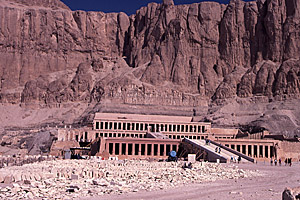
(Thebes, Aswan, Egypt)
We decided to walk back. It was not all that late and a slight breeze meant that it was only boiling hot. We climbed back up the track to the cliffs above the valley past a motley assortment of people trying to sell small stone carvings but not well enough to pay the bribes necessary to work the main streets of the valley itself. The path curved around and took us over the top of Hatshepsut's Temple which enabled us to see inside it. From this we worked out that it was not much more than an impressive facade. The murals of the Queen's journey to the land of Punt (modern day Somalia) to retrieve some seedling of myrrh trees are meant to be interesting but our attention span had taken a severe battering in the melee of the Valley of the Kings so we decided to pass. We followed the path down and this took us practically right up to the huge ramp that bisects the facade and takes the tour groups up through a series of courtyards. Anyway it certainly looked like a good place to stage Aida...
After this the route was very simple, we cut through the village of Qena practically walking over the top of, but not noticing, the Tombs of the Nobles, then walked about a kilometre back along the road to the hotel. We were back before ten and so sat down straight away and had breakfast in the shade of the Hotel's courtyard. And that was about it for the day. Anna worked and I started reading the first part of Naguib Mafhouz's Cairo trilogy which I had bought the day before in order to work up some enthusiasm to go to the place. We drank a lot of Karkady, an Egyptian tea brewed from hibiscus flowers which looks and tastes a lot like hot Ribena. It was quite a good arrangement although the Egyptian Tourism Agency should take note that if it were not for the fact that everything closes at 1700 they could have got some more money out of us because it is only after this time that you would possibly contemplate going anywhere - especially if you had been sitting under the shade of a tree all day drinking Karkady .
Tuesday, 10 August 1999
Thebes, Aswan, Egypt
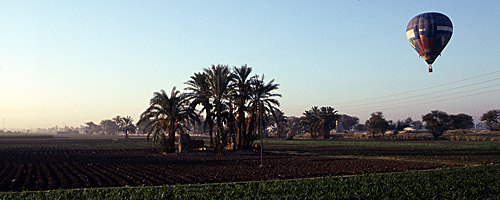
(Thebes, Aswan, Egypt)
We took it a little easier getting up at around 0530. What woke me up in fact was the sound of the gas burner of a hot air balloon. We had seen them the day before from above and read about them in our guide book. People pay a lot of money to take a morning balloon flight over the top of all the ruins of the Necropolis. However from what we saw the day before they barely got off the ground and the lack of any wind meant that they hardly saw anything. Today was no different, the basket of the balloon was hanging just above the level of our window and was about 50m away. We watched them whilst we got ready and in about fifteen minutes they barely managed to move 10m. I am not sure whether the occupants of the basket were ripped off but they certainly would have seen more by just getting out of the basket and climbing a hill.
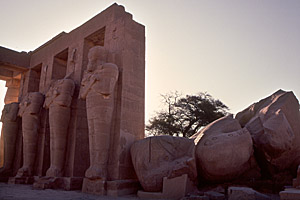
(Thebes, Aswan, Egypt)
Today we had decided to go to the Valley of the Queens and the mortuary temple of Ramesses II, otherwise known as the Ramesseum . It was a toss up between the Valley of the Queens and the Tombs of the Nobles, which we were informed were a lot more interesting, however the baksheesh opportunities at the very unorganised looking Tombs of the Nobles looked endless and we were worried this would be a bad start to the day even if we could find the attendants to open them. We went to buy the tickets and then after some rumination decided that it would be best to visit the Ramesseum first since there was still a lot of early morning mist around and the lighting conditions were good.
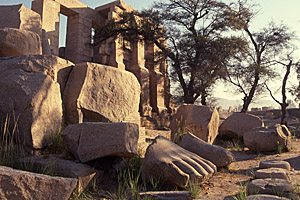
(Thebes, Aswan, Egypt)
Ramesses II was not a Pharaoh that was afraid of blowing his own trumpet and as well as having huge images of himself hacked out of the mountainside at Abu Simbel he decided to erect an 18m granite colossus of himself with the modest inscription "Ruler of Rulers" carved on its biceps in his mortuary temple. the tragedy was that he built the temple too close to the flood plain of the Nile and pretty soon it started falling apart. During an earthquake the torso of the colossus toppled backwards smashing the second pylon into the courtyard behind. Resisting an urge to climb it and stand on his chest I circled the colossus taking a few photographs. At the foot of the pedestal two huge granite feet lie stranded in the sand and tufts of grass. The fact that we were the only people there made the whole scene very magical. Beyond the courtyard there was a hypostyle hall which had still retained a lot of its roof and you could make out a lot of the carvings on its underside. Around the site several shattered steles and fragmented black colossi had been reconstructed. It was clear that if Ramesses II had placed it a bit more appropriately, and the British Museum et al. had not removed half of it, his mortuary temple would have been one of the most impressive monuments in Egypt.
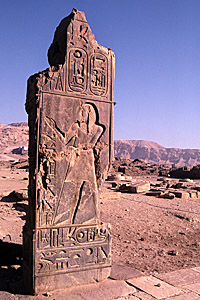
(Thebes, Aswan, Egypt)
The walk to the Valley of the Queens was very short since it lies on the near side of the mountains just behind Medinet Habu. Very few of the tombs are open and the most famous of these, Queen Nefertari has been given a E£100 price tag to keep the number of visitors down and protect its delicate murals. So that just leaves three and to be quite honest when compared to the Valley of the Kings there is not much to see. However it can be said that it is not a fair comparison because, as with the Tombs of the Nobles, the decorations do not follow such a strict format so you see different things. What is certainly different is the mummified foetus in a case in one of them which, unless like us you avoid him, the attendant "lends" you a torch in return for baksheesh.
Again its difficult to find something to say about the rest of the day since we spent most of it either catching up on sleep, reading or working. The format was getting a bit boring but Anna had to get on with her work and to be frank we had already seen enough of the Necropolis.
Wednesday, 11 August 1999
Thebes, Aswan, Egypt
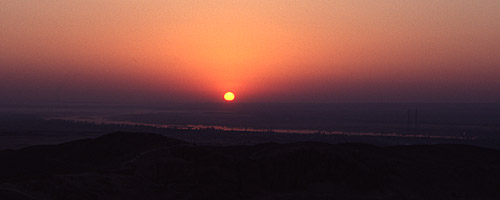
(Thebes, Aswan, Egypt)
Our last day we decided that watching the sun rise over the Nile was such a fantastic experience that it deserved to be repeated. It was made all the more symbolic by the fact that, had we been in England, we would be seeing two sunrises that day. Yes it was eclipse day and somehow we had ensured that we were as far south as possible and so were missing the first total eclipse to hit central Europe for forty years. Anyway knowing the way we left slightly earlier and as a result the moment the sun's disc appeared and the Nile became a glowing red ribbon we were installed on the top of a small bluff with a grandstand view of everything. Again it was magical to watch and made the whole getting up early thing worth its while.
We had also decided to repeat our trip to the Valley of the Kings, this time picking three different tombs. The first we visited was the slightly forgettable Ramesses III. I say this because although the corridors are very nicely decorated and have a unique series of ten niches used to contain funerary objects, the burial chamber has been closed since its roof collapsed and show no sign of being repaired. Meanwhile we had to be content with descending down a gloomy ramp and staring into the pitch black dark tunnels from behind a rail. It was a pretty spooky experience enhanced by the fact that we were the only people in the tomb. The only other detail of the tomb I remember is that there is a kink in it caused by the fact that during a previous Pharaoh's attempt to construct it the builders burst through into a neighbouring tomb. When Ramesses came to build his tomb they resurrected the unfinished tomb and got around the problem by shifting the axis of the tomb slightly to one side.
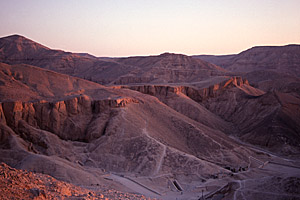
(Thebes, Aswan, Egypt)
Next we visited the tomb of Tuthmosis III which really was a cracker. Like that of Amenophis II who was in the same dynasty it was built more with protecting the body in mind than with the religious symbolism employed in the Ramesses' tombs. You first have to climb up a staircase erected to take you into a wadi high above the valley floor then along the wadi and down, down, down into the tomb. After what is truly a descent into the underworld you find yourself in a vestibule the walls of which have been divide into a matrix of squares and in each square a black line drawing of one of one of 741 deities has been executed with its cartouche next to it. It is quite unlike anything we saw in the other tomb although it was apparently de rigeur at the time. Down a ramp in the vestibule floor you reach the burial chamber. It is different in that it is rounded at both ends but this allows the illustrations to wrap right around. Again the illustrations are not of the highly decorative sort and are executed in a sort of "matchstick" style. All of the ramps and passages of the underworld are clearly mapped out and al sorts of weird creatures are depicted. Unlike in Amenophis II you can actually approach the quartzite sarcophagus. The carvings and spells on the lid are beautiful and again you can see the arms of the sky goddess nut carved inside the sarcophagus. If someone asked me which three tombs they should visit this would definitely be one of them on terms of sheer atmosphere.
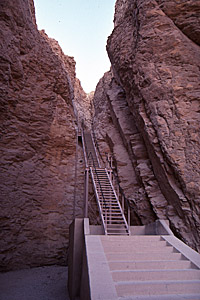
(Thebes, Aswan, Egypt)
We were a bit stuck for a sixth choice - nothing really stood out in our guidebook. We decided to opt for Ramesses I which although it is very small was supposedly quite well decorated. Sadly it did not quite cut the mustard and after a one minute tour we left. Outside the heat and the crowds were a pretty good indication that it was time to leave. Instead of the route via Hatshepsut's temple we decided to head back the way we came, avoiding the people selling unidentifiable stone ornaments and offering to show you the way for baksheesh. Within half an hour we were back at the hotel and were again faced with the problem of what to do for the rest of the day.
The amusing highlight of the day was the Solar Eclipse. We were in the 40% zone which meant we would see something but not much. Sadly we did not have any "Free with the Sun" eclipse viewing glasses so we had to fashion a substitute. We tried to smoke some glass but for some reason the soot would not stick. In the end one of the guys from the hotel found some ink and we used this to produce a very ineffective defence against the sun's rays. Anyway the amusing thing was not the eclipse itself but the Egyptians' attitude towards it. They had been told that it was dangerous to look at and ha interpreted this as a warning to stay indoors. Normally everyone would hang around in the leafy courtyard of the hotel. Today they dared not venture outside. When one of them finally did brave it he regaled us with stories of how whole families had barricaded themselves in with emergency food supplies. Certainly there was no-one in the fields and no-one on the roads. Maybe they had misread eclipse as apocalypse?
We finally ventured out around six although this was only a precaution against the ferry service stopping for the night. We had dinner in MacDonalds, a precaution against the stomach troubles which had plagued me on our last long train journey, and then hung around. Our train finally came and when the carriage attendant asked for baksheesh for showing us to our seats we politely informed him where he could stick it. We slept very badly through the night. The continual switching of the a/c on and off in an attempt to save money was augmented by a German guy behind us having a bad dream and waking up screaming. Under the circumstances we did not blame him.
Thursday, 12 August 1999
Alexandria, Egypt
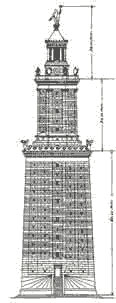
(Alexandria, Egypt)
There is something very wrong about the people working in the ticket offices at Cairo train station. The way they look at you cannot fail to induce in you the feeling that you are not going anywhere. Its a look that says "I've got all the tickets but you ain't gettin' none pal". It is a wonder that it takes the majority of foreigners as many as four rounds of being sent between different windows and rooms before resorting to threats and bribery.
We had decided to get straight off the overnight train from Luxor and straight on to an Alexandria train but of course there were no tickets for a day. Another English couple were having the same difficulties so we decided to take them under our wing and show them the Egyptian system. We all walked onto the train and simply sat down. Of course the seats we had chosen were booked but after a lot of chopping and changing and standing for half the journey we got a seat. Worse than this we had to contend with people who pretended to have our seats who in fact were as seat less as us but not as clueless. The other couple looked rather shocked by the whole experience but I guess like us were forced to conclude that anything would be better than being stranded in Cairo for the day.
If Egypt and Egyptians are getting on your nerves then Alexandria is the perfect remedy. To put it simply if someone approaches you on the street they are more likely to be offering you directions than trying to sell you a tour, perfume, a camel ride, a felucca trip etc. It is a town that is too focused on itself and Egyptian tourists to bother with the independent traveler and as a result is hassle free. Moreover it has a faded elegance, not quite all the traces of its cosmopolitan past have been erased. It is a city of leafy boulevards, quiet squares, aging patisseries and the sea. Well maybe I am exaggerating a bit but the fact remains that if I was forced at gunpoint to live in Egypt Alexandria would be the only sane choice.
We sadly lost most of the day trying to resolve money matters. We were en route for the desert oasis of Siwa which we were informed has no bank and certainly no cash point. Bizarrely Thomas Cook were unable to contact Cairo's overstretched Visa authorisation despite numerous tries and the only cash point we found refused to function. Eventually we got the cash point to work but from its complaints I realised that an earlier attempt to withdraw money from it had resulted in the cash disappearing from my account put not popping out of the machine. We were forced to take what little remained of my shattered daily limit and then change some travelers cheques. I was not sure what would become of the magical disappearing money but since it was Thursday evening there was no way of sorting it out at least until Sunday.
This whole debacle left us with little time to look around and the only thing that we attempted to see, the Cavafy museum, turned out to be closed by the time we got there. Still, we said to ourselves, there is only one way in and out of Siwa and so we would be coming back to Alexandria soon enough. Getting tickets proved to be the usual frustrating affair. The old ticket seller first told us there were no tickets, so we asked him to look again. He deliberated and it was clear that he was fishing for some baksheesh but we played dumb and eventually got some tickets for the bus the next morning.
Having been stuck out in the fields of Luxor for days we were naturally gasping for a beer and so were determined to make a night of it. We found a restaurant where although the food was mediocre it was more than made up for by the fact that the tables overlooked the kitchen where a baker was making an amazing variety of bread. The procedure involved spinning the stuff around his head, slapping it down and folding it up to capture layers of air. After I had abandoned my over salty pizza we made a beeline for the nearest pub. Here we were spoilt for choice as Alexandria has many discreet drinking dens. Our chosen venue, the Spitfire bar, turned out to be very warm and inviting and oozing with atmosphere. Ignoring the Rovers Return in Amman it was the closest thing to a pub we had been to since we set foot in the Middle East. We stayed for one then moved on, walking through the, by now, very lively streets to a sort of restaurant bistro type affair where we had a very cosy nightcap.
Friday, 13 August 1999
Siwa, Matruh, Egypt
You always end up paying for a good night out and in this case the price was loosing half the morning to our hangovers. The worst thing was that what the day had in store was less appealing, a nine hour bus journey through the desert. Anyway we turned up at the bus station and took the seats that we had fought so hard for and settled in for the day. Of note on the journey was Egypt's Med coastline which seemed to be nothing but an endless string of unfinished holiday homes and El Alamein. This battleground was such a dull featureless plain that you wondered how it would be possible for Montgomery and Rommel not to be struck by the futility of it all and immediately bugger off to the beach to work on their respective tans.
Heading inland from the coast the Sahara proved to be no exception to Jacob's law of cinematic misrepresentation of deserts, it was flat and featureless and there were no dunes. However when we finally pulled into Siwa it was a revelation, two massive salt lakes surrounded by kilometres of doum palm groves in the midst of a wilderness. If only it had been a bit smaller it would have matched perfectly the image conjured up by the word "oasis".
By the time the bus pulled into Siwa Oasis dusty central square it was pretty late. We were glad to find the manager of the hotel we had picked waiting for the bus and that the Palm Trees hotel did have rooms free. We dumped our packs then started asking around for tours to Bir Wahed or "Well One" a spring on the edge of the next door Great Sand Sea. We concluded over dinner that as usual the price of the famous tour had gone up, the guides were of dubious character, their jeeps of a dubious vintage and their itineraries of a dubious flexibility. Nevertheless we signed ourselves up for an evening trip and "Inshallah" we were in for a good time.
Saturday, 14 August 1999
Siwa Oasis, Matruh, Egypt
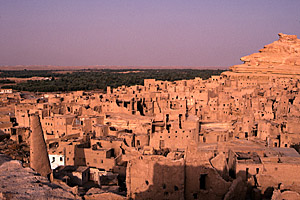
(Siwa Oasis, Matruh, Egypt)
After twelve months of travel, a week of getting up in the dark in Luxor and the day after a nine hour bus journey you would think we would have had a lie in. Not us, no siree Bob! We were up with the larks scrambling over a hill of rubble in the centre of town more properly known as the ruins of the town of Shali. The first families of Siwa lived on the handful of sandstone outcrops dotted around the oasis. They built maze like cities of mud enclosed by defensive walls which now have been mostly abandoned in favor of breeze block affairs. We climbed to the top of Shali through the abandoned shells and from the top soaked in the view of the oasis. It is a bit difficult to explain exactly how big the oasis was. Again the desert seems to have badly misrepresented. Rather than just being a huddle of palm trees around a small pool the oasis was bounded on two sides by two vast salt lakes and between them an area of about 10km was covered by dark green date palms. We had thought we were going to take it easy that day but we decided there and then that we wanted to do a bit of walking around. We flicked through the guide book and picked a point to aim for. We decided on Aghurmi the first knobbly rock that the Siwans decided to build on.
We set off through the town and quite soon the buildings started to run out and we found ourselves walking on a tarmac road cut through a series of pretty scrappy looking farms. From time to time the date palms rose up around us but most of the time there was very little shade and we realised that our spontaneous decision to go for a walk was all well and good but next time water would be a good idea. Anyway eventually we got to the foot of a series of outcrops which we assumed was Aghurmi. We climbed to the top of the nearest but found no buildings on it, we traversed to the next, still no buildings, it was not until the third that we spotted where we should have gone far off in the palms. We had gone in the wrong direction, not totally the wrong direction, but the wrong direction nevertheless and we were going to have to do a bit of a triangular walk. However it was not a wasted journey because we also realised that we were on Jebel Dakhrour, the site of the yearly tourism festival where everyone from the oasis gets together and basically camp out together and party. Moreover there was a splendid view of the whole oasis and especially one of the salt lakes which spread out just below us.
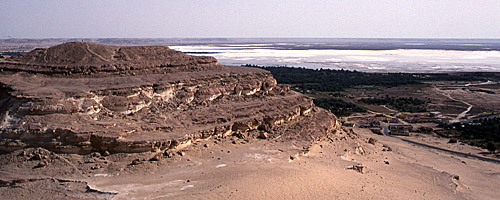
(Siwa Oasis, Matruh, Egypt)
The walk to Aghurmi was at least a bit more oasis-ish on account of the fact that there really was not much of a road going in the direction we wanted to and we were forced to utilise some dusty donkey tracks. On all sides we were hemmed in by doum palm trees and, surprisingly, irrigation channels. The thing was that Siwa was absolutely bursting with water and even in the middle of summer it gushed out of every available hole in the ground. We had to get directions off a couple of locals riding past on their donkey traps but we finally got to a small clearing in the palm trees in the midst of which was what remained of the oracle of Amun.
The Oracle of Amun was at the time of the Hellenic empire considered second only to those in the motherland. Alexander the Great seeking confirmation that he was the Son of Zeus consulted it, although he never revealed the answer to anyone, and Eubotas of Cyrenaica an athlete on his way to the olympiad was so confident in its projections that he even commissioned his own victory statue before the event. What is left is evocative and atmospheric but if you did not know a bit about the history it would be difficult to guess that these fragments of wall and pavement barely cleared of vegetation were at all significant. A small walk away the ruins of Aghurmi were a bit more substantial. Again a maze of buildings atop a rocky outcrop Aghurmi was distinctive because of the wall encircling it. Slowly we began to understand the lives of the early Siwans, stuck out in the desert, isolated, a weeks camel journey from anywhere. Nomadic raiders would often swoop out of the desert and attack the settlements, hence the heavy defences. There are very few places that feel cut-off from the rest of the world but Siwa is getting there. There is a story that in a neighbouring oasis they once lost track of which day it was so had to send a rider to their nearest neighbour in order to work out when it would be Friday the day to go to the Mosque.
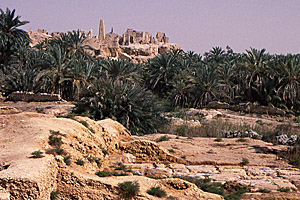
(Siwa Oasis, Matruh, Egypt)
The walk back to Siwa town was hot but not too long. Anna was overly concerned about our lack of water and started to worry that we would die of thirst, fortunately she did this just as I caught sight of the minaret of the town's mosque and I was able to laugh at her with at least some confidence. We staggered back into the market square gasping for water and once our thirst had been slaked turned our minds towards food. We picked the "East and West", a joint popular with travelers and ordered some distinctively western fare.
Waiting for our food an American by the name of Alexis introduced himself. He was trying to get some bodies together for a trip to Bahariya the nearest oasis to the west. The problem, as we knew from the guide book, was that there was no public transport between the two and you were forced to hire a jeep and split the astronomical cost between as many people as possible. We initially said no because we had planned to go back via Alexandria, but the more we talked to Alexis the more tempting the thing sounded. After all it would take us back towards Cairo and we were kind of getting into life in the Sahara. We sat and talked about it some more. They wanted to hire a jeep to take them to the White Desert between Bahariya and Qasr Al-Farafra the next oasis south on the desert trail. They wanted to spend a couple of days there but had to get back to Cairo because one of the group had to catch a flight the day before ours. With Alexis was a German girl who would be coming along and she said she was quite friendly with a guide who would make us a good price. She seemed a bit vague about what the price actually was but the figures she was tossing around sounded like it would be a bargain.
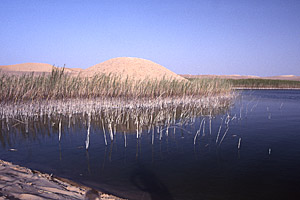
(Siwa Oasis, Matruh, Egypt)
In the end we decided to go for it. It turned out that the guide that the German girl knew was actually the guide that was taking us out to Bir Wahed that afternoon. Anyway we had an okay lunch and arranged to meet up with the guide later and Alexis and co the next morning. We wasted the rest of the day and eventually Ahmed, our guide, turned up at the Palm Trees and together with an Irish woman we piled into his Land Rover. It would be easy in the light of what happened with Ahmed to start picking apart this mini-safari but the truth is it was perfect. There was one slightly odd incident at the start involving some mix up with the German girl Anya. Ahmed thought she would be coming with us to Bir Wahed and had paid for a visitors permit for her. Anyway we found her in the streets and when she refused to come along and insisted that it was all Ahmed's mistake he had a mini-fit. We were a bit perplexed by the whole performance at the time but it fell into place later.
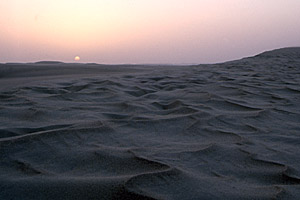
(Siwa Oasis, Matruh, Egypt)
Bir Wahed itself was amazing, a lake in the middle of the sand dunes it sported reeds and even fish. We lowered ourselves gingerly into its green cool waters and the juvenile fish started nibbling us, I think eating bits of dead skin. Ahmed had a neat trick of staying underwater for a long time and swimming underwater and grabbing your feet to make you think there were bigger fish around. We eventually had a go at it and I was amazed, the water was very green and looking around underwater was wild as it was like being in some sort of radioactively luminous soup. After chilling out by the lake for a while we moved on to a hot spring. Here one of the guides had built a small garden and attached a well head complete with an opening valve so that the fountain of hot water could be turned up or down. We steamed for a while in its waters and amazingly when we got out the air around seemed cool. Following this we were taken to a fossil bed - it was basically an area packed with fossilised sea shells and sea urchins a reminder that despite being desert now the whole area was at one time under the sea. We then went to an area of sand dunes to watch the sunset, which was okay, and then in the dark went to visit a place where a hot and a cold spring next to each other had been tapped to create a sort of temperature controlled shower affair. The whole tour was great and Ahmed was very amusing, and I'll leave it at that for now.
Sunday, 15 August 1999
Siwa Oasis, Matruh, Egypt
The day did not start off well. We attempted to have breakfast in the hotel but the laid back Siwan attitude was beginning to look like laziness. It took an hour for the breakfast we ordered to show up and it looked like Ahmed was a no show as well. He turned up a lot later and asked us where the other guys were. We informed him that we did not have a clue and it was really nothing to do with us. But a look on his face told me that he was not going to be arsed to do anything. He had told us that he would need to get our passports to the police so the permits to travel through the desert could be processed. So I did his job for him, I went round to the hotel where Alexis, his brother Chris and their friend Bjarna were completely comatose in their room and arranged to meet them at the restaurant opposite the hotel for breakfast. I got back and told Ahmed this however Ahmed did not want to meet at the restaurant because they ran a tour agency etc. It was all starting to fall apart.
Basically it was a lot of confusion during which we had to check out of our hotel and find everyone including the seventh and eighth members of our group, a Polish couple that wanted a ride as far as Bahariya. We oscillated between one restaurant and East and West until finally we were all sitting down together. This was when the thunderbolt struck home. We agreed an agenda with Ahmed then we shifted to price. Whereas he had told Anya that he wanted 1000 E£ for the trip he was now talking about 1800 E£ (£350 in proper money). We were a bit thrown and he had us by the balls, we all needed to leave that day and because it was now almost twelve there was no way to arrange another driver. Thinking about it in retrospect we realised that this was probably not coincidental, Ahmed had dished out conflicting and vague instructions, had turned up very late himself and had not got everyone together. Could it be that he wanted to put us in the position of not being able to turn him down?
Worse than this he seemed to being vague about who would drive us and what sort of jeep we would take. He told us that he would probably drive and if not we would get a driver and guide as good as him. Being a veteran traveler I translated this to mean "No, I am not coming with you, if you are nice to me I will put you in a jeep with all four wheels and the guide I am giving you's command of the English language stretches to the words 'desert' and 'money'". I was not far wrong as it turned out. But he promised that if we were not happy with his replacement he would come himself. We gave him part of the money and then split up, the guys still had to check out and everyone had to get some lunch.
Over lunch Anna and I fumed, I started to regret getting into the whole situation and if it had not have been for the others I would have dropped out that instant. Ahmed was trying to pull a fast one over on us and we had discovered by accident that he was taking a group of three girls to sleep out in the desert that night. His promise was not one that he could keep and he had other priorities. In fact we had pretty quickly figured out what they were - women. The previous day Ahmed had told us that he wanted to take a western woman as a second wife. He needed a second wife. He told us he had to have sex twice a night otherwise he could not get to sleep and his wife was not able to satisfy his drives. Anya, rather unwisely in our opinion had befriended him earlier in the week and being a young blond German girl traveling solo he had offered her free day trips which she had taken. The aborted attempt to take her to Bir Wahed was only the end of a sequence of free trips. We guessed that when she turned him down he began to realise that he was not getting anywhere so changed tack. The original price had been discounted when he was on the pull but now he had been blown out, and had three other girls lined up, we were going to be taken for every penny we had.
We were not the only ones seething, when we finally all got together at East West we found out that everyone had been thinking along the same lines. We drew up a plan of attack, the Danish guy Bjarna wanted to hit him but we managed to come up with something a bit more moderate and then waited for our prey. In the end Ahmed took the piss, he did not even come to pick us up. What turned up was a friend of his in a jeep which would have been difficult to fit six in let alone ten and a guide who was either unwilling or unable to talk English. He signed to us that we were going to rendezvous with Ahmed. We just laughed punching our fists into our hands with a grinding motion. We drove out towards the salt lake and then took a road bisecting the lake which reminded us intensely of the salars in Bolivia. The sun was setting, all in all it looked like there was going to be one hell of a backdrop for our show down.
Even if by this time you think that we were wrong you have to admit we had balls. We basically surrounded Ahmed and shouted at him calling him a cheat and a liar, totally oblivious to the fact that we were out in the desert by now and his two jeeps represented the only way back. He was very indignant about the whole thing and my favourite quote when recounting the story between us during our trip was "I have been in the business for fifteen years and I have never never seen anything like this". He almost had us convinced that he was being falsely accused and I do not think I will ever be entirely sure that we were right in our accusations. But what was undeniable was that he was trying to juggle too many balls and he had just picked the wrong people to try and fob off with an English less guide and a miniature jeep.
However much we had insulted his "honor" he was still a businessman and we still wanted to get on the move that night. We arranged a lift to Bahariya for a pretty standard price and said we would sort out onwards transport from there, which is probably what we should have done all along. We set off into the night at full speed on a road that disappeared almost instantly and just became a set of tyre tracks. The only thing that punctuated our odyssey that night were the numerous police check points in the middle of nowhere. On a 700km stretch of road there were six checkpoints, all of them manned by very bored looking guards to whom we represented the only form of entertainment that night. Naturally it took us hours to get through each of them. As if that was not enough the driver, a tall, very even tempered Siwan who I think had a lot of sympathy for our situation, drove like a complete madman.
After about three hours of driving we began to realise that their plan was to drive all night as fast as possible to get to Bahariya the next morning and then get back to Siwa the same day. We did not want this and kept on telling the guide to stop so we could sleep, he would tell us that there was no soft sand and that there was a great place in ten minutes. Twenty minutes later he would still be driving and we just got more and more wound up with him. We were getting sick of them, they could never seem to give us a straight answer. In the end they stopped at an army checkpoint and told us this was where we were sleeping. Why?, "Because there are wild animals". They were basically telling us to sleep round the back of the checkpoint. This sparked off another row as we had come to the desert to sleep in the desert amongst other things. It all got a bit ugly, the soldiers tried to persuade us that it was dangerous but in the end it was our tall driver that diffused the situation. After bodily lifting up the agitated Bjarna on to the roof of the jeep he led us off into the darkness. He was not afraid to sleep in the desert and he grabbed his blanket and lead us off into the darkness. The guide I assume stayed in the safety of the checkpoint compound....
Monday, 16 August 1999
Bahariya Oasis, Sohag, Egypt
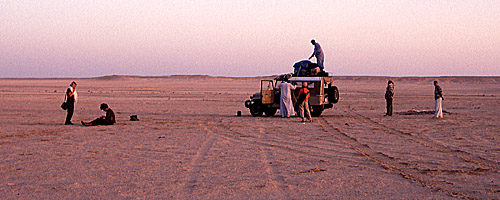
(Sahara Desert, Sohag, Egypt)
Spending the night on some gravel behind a military checkpoint in the middle of nowhere is hardly the romantic ideal we had set our sights on. In retrospect we probably had only ourselves to blame, with a bit more money we could have organised something a bit more leisurely, sleeping the nights at oases around roaring camp fires etc. However this was money that none of us at the time had and as the saying goes "you get what you pay for".
We were woken up early to avoid the heat and bundled into the miniscule jeep and drove off into the gravel. To this day I will have no idea how we all fit in there, I seem to remember the procedure had something to do with legs being dangled out of the back and taking it in turns to lean forwards and back. After a long time, we had our one and only break in the scenery, some dunes. Nobody could resist the temptation so we got the driver to stop and we all popped out of the jeep and ran as far away from it and our guide as possible. I ran to one dune to take some photographs whilst the others scrambled to the top of another. I joined them just in time to catch Bjarna diving headlong off the crest into the soft side of the dune below. This started a trend and within seconds we were all "dune diving" and generally having a laugh despite our driver repeatedly beeping the jeep's horn.
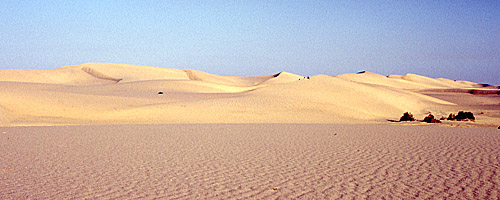
(Sahara Desert, Sohag, Egypt)
However not everyone was in the mood to play. The two poles had taken their Lonely Planet a little too literally and thought that by hanging around they were going to miss their bus. They clearly had not realised yet that in Egypt a timetable is more a rough statement of intent than an exact guideline. Anyway the long and the short of it was that the girl, Ana, after waiting in the jeep for a while, completely freaked out and stormed up the dune towards us. "Why are you behaving like five year olds?" did not illicit much more than an amused smirk from Bjarna, but "We must go before it get's too hot", followed by a few dry sobs, started to make us feel guilty and so we trudged back down to the jeep.
The rest of the journey was pretty much more of the same, driving at an amazing speed through gravel and only stopping to entertain bored guards at checkpoints in the middle of nowhere. The last checkpoint took an age and Chris virtually had to repeat his entire life history for the benefit of the guards. I guess in the middle of the desert there are very few books. Eventually we saw some low hills in front of us and as we snaked our way between them we descended into Bahariya Oasis . The second we pulled into the centre of Bawiti, the oasis' main town, the panicked Poles, thinking they had just made it, leapt out of the jeep and asked a bemused looking local where the bus stop was. The reason for his bemusement, the bus had left two hours ago. All rather predictable but fortunately for them there was another bus five hours later so their schedule was not completely blown to pieces.
Meanwhile we were already being harassed by a dozen jeep drivers for details of our next plans. We felt a bit sorry for the driver of the jeep we were leaving behind because he was keen to carry on with us and we had grown to like him. After all none of the mess was his fault, it was down to Ahmed, and despite speaking not a word of English he had managed to communicate with us more than our so called guide. On top of this it was pretty much "out of the frying pan and into the fire" since the guys buzzing around us now looked like they knew Ahmed very, very well. One guy in particular had been virtually stuck to us from the start and we began to suspect some phoning ahead had been done. So after lunch we opted for a bit of a diversionary tactic, Chris and I went off to this chap's office to discuss itineraries and his inflated prices whilst Alexis and Bjarna found somebody a little more "independent".
Sammy was driver and guide thrown into one, he spoke excellent English, gave us an excellent first price, had a genuine Land Rover and was ready to go there and then. He took us to a nearby store, we loaded up with an immense amount of water and a load of provisions and, with only a quick stop to pick up some pots and pans, we were off. However since by this time it was quite close to three we took Sammy's advice and decided to pitch camp at a village just down the road from Bawiti where some of his relatives lived. It was a good choice, we first went for a refreshing dip in a local hot spring then were taken to his relative's farm. Here we ate fresh figs, picked watermelons and bought a duck for dinner. The duck story was long and very funny because Bjarna and Alexis were both lapsed vegetarians. We were taken out to the duck pond at the back and they immediately saw the situation as some sort of right of passage. Much debate was had as to whether it was best to take the ugliest duck or whether we felt sorry for it and should pick the most arrogant looking duck instead. Following this there was a big debate about who would watch it getting slaughtered, in the end out of the two of them only Bjarna was able to stomach it.
That night we had a total desert style party. We set up camp in some dunes just outside town, collected some firewood (which there was plenty of) and lit a roaring fire. We had an amazing dinner after which Sammy disappeared which was the cue for Chris to bring out his alto sax on which he improvised a few superb tunes. Alexis had by this time manufactured an undeniably bong like hubble-bubble out of mineral water bottles and produced some of the greasy tobacco used by the locals (and no! the baccy was in no way whacky before you start to make up your own plot here). It was a fairly rough smoke not enhanced by the fact that despite insulation the hot coals were slowly singeing the plastic however we made it through a couple of rounds. When Sammy returned he bought with him some of the local lads to, depending on your point of view, either (a) sing and dance or (b) ogle and ineptly try to chat up Anya. Sammy then borrowed Alexis' bongos (yes, I know this is sounding a bit traveller-ish but bear with me) and then transformed himself into an amazing songsmith, sort of rapping to simple tunes in Egyptian with the odd word of English. It was without doubt the wildest campfire night we had in our years travel and without a drop of beer....
Tuesday, 17 August 1999
White Desert, 6th Oct, Egypt
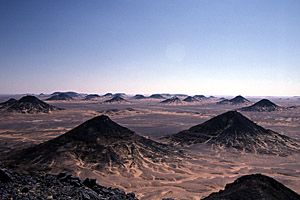
(The Black Desert, 6th Oct, Egypt)
One of the benefits of non-alcohol based partying is that the next morning you feel fine. If however you party then wake up the next morning to the rays of the rising sun in a sleeping bag in some cushion soft sand dunes it is more than fine, it is bloody amazing. Well this is a bit of a lie because there was a major insect problem which kept nearly everyone half awake all night but it was amazing nonetheless. We slowly packed everything up and loaded it back into Sammy's battered Land Rover and then set off for the Black Desert. On the way we stopped at something known in tourist circles as the Crystal Mountain but since this was just a small outcrop of crystalline rock it did not illicit too much excitement.
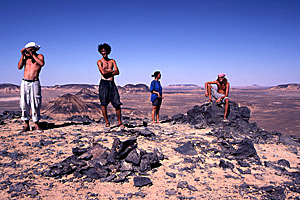
(The Black Desert, 6th Oct, Egypt)
The Black Desert itself, on the other hand, illicited copious amounts of excitement. Sammy pulled up beside a huge and perfectly cone shaped volcanic cone and Bjarna promptly jumped out and raced to the top followed closely by the rest of us with the exception of Anya, who sent her camera instead. On top of the cone the view was amazing. For miles around there was nothing but cones, scorched desert and rainwater channels. The cones were covered in slabs of black basalt some of which were glass smooth and shone in the sun. In between the basalt were dotted deposits of more unusual minerals some purple, some yellow, it was like a geography teacher's wet dream. We took lots of photos, relaxed for a while then decide we were getting pretty hot and thirsty so returned to the jeep. Predictably while we were away Sammy had asked Anya to marry him. She seemed only slightly annoyed by the proposal.
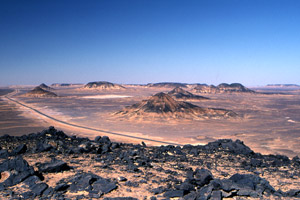
(The Black Desert, 6th Oct, Egypt)
Pretty soon afterwards we were speeding over the volcanic plains towards Qasr-Al-Farafra and the White Desert. We climbed slightly up to the Naqb el-Silum pass and then dropped down into the bowl of the Farafra Oasis. About 30 kms before Qasr-Al-Frafra we veered off the road for our first bit of "off-roading". As with our previous jeep in sand experiences in Jordan this involved a lot of alarming lurching around this time to avoid large rocks as well as loose sand. After a short while we hit what we would have been given to believe was the "White Desert" and Sammy pulled up under the shade of a bizarre, weathered, chalk-like, mushroom-shaped rock. I think the plan was to sit out the afternoon in the shade of this rock but we negotiated with him to take us a little bit further into the formations. On the way Alexis, who was at the time climbing up the ladder to the roof of the Land Rover, managed to fall off. It was about five minutes before we noticed and turned round. When we finally found him, unhurt, he looked understandably stressed.
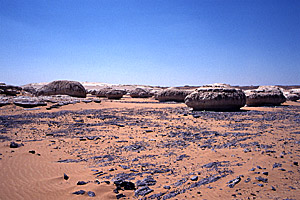
(White Desert, 6th Oct, Egypt)
Sammy did not disappoint and it is a big shame that I did not get a picture of where he took us, but I guess it gives me a good opportunity to try some descriptive writing. Imagine, if you will, a desert plain with a few widely spaced white dome like formations. On a low formation imagine a gnarled pine tree, hundreds of years old, with its root clawing into the rock itself. So old that its root system stretches down to some underground river or water reservoir. So whilst everything else is dead and barren the tree is green and forms some amazing mini-ecosystem with silver ants crawling around its roots and silver bees flying around its branches. We relaxed in the shade of this tree for most of the afternoon. Bjarna took a sort walk, then Alexis and Chris took off into the desert and finally Anna and I went to explore some bizarre knee height garden of weathered rocks. We all made it back to the tree for an amazing lunch that Sammy had prepared. After this we lay back on the carpet of pine needles and engaged in the traditional mid afternoon activity of the desert siesta whilst all around us the silver ants and bees went about whatever it was they were doing.
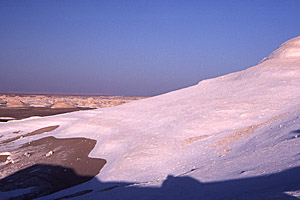
(White Desert, 6th Oct, Egypt)
Well all guides exhibit at least one of the seven deadly sins and Sammy's was sloth. His plan was undoubtedly to go back towards the road and hook up with another tour group that would be camping there that night and smoke some hubble-bubble with his fellow guides. We had other plans however, we were very happy with our own little group and wanted to go a bit further off road. You see one thing Chris and I had gleaned from the diversion in Bawiti was that the white desert was large and the mumblings about an "Old White Desert" and a "New White Desert" indicated to us that if only we could get Sammy to take us a bit further we would see something quite amazing. However we had a problem, one of the wheels had been punctured the day before and Sammy had not followed the convention of carrying two spares. So now we had no spare. Sammy admitted after a bit of goading that there was more to be seen but wanted to borrow a spare off his friend before he would even consider the trip. Whilst we waited for them near the road we climbed a huge domed hill of weathered chalk that looked a bit like a snow covered mountain.
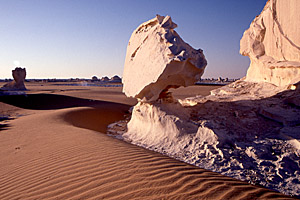
(White Desert, 6th Oct, Egypt)
Of course the friend never turned up at the appointed time and a bit of an argument broke out between Alexis, Sammy and Bjarna. I was a bit tired of all the arguing so kept my distance but the conclusion was that it was over forty minutes of off-roading away and because of this we would have to pay extra. Everyone thought this fair enough and so we set off into the rapidly setting sun. The forty minutes turned out to be ten but another round of arguments was out of the question. The area of the White Desert Sammy had taken us to was without a doubt one of the most breathtaking places we had ever been. We were surrounded by a forest of white pinnacles of weathered chalk, pristine sand dunes wrapped around their bases and the rose red sky touching their tips. We wandered around, our jaws literally hanging open. We hardly registered each other so naturally we got split up and totally lost.
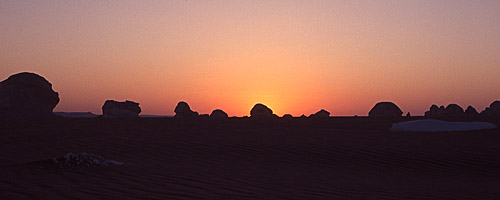
(White Desert, 6th Oct, Egypt)
Eventually Anna and I returned to the jeep to find Sammy cooking so went off in search of the others. We eventually tracked Alexis and Chris down by their whispers and sat with them for a while staring up at the stars. All, however, was not well. Chris was feeling weak and nauseous and when we finally got back to camp he could not eat any of the excellent food that Sammy had cooked up. Partly because of this and partly because of the surroundings we had a much more restrained evening by the fireside. I remember spending a good part of it chatting to Bjarna who, it turned out, was a student of parapsychology and despite an initial fear that I might be skeptical he managed to make quite a good case for the subject. I must point out before you start to worry that it was only quite good. I mean by the end of the chat I was not so much convinced in the existence of ESP as reassured that Bjarna was not completely mad. I went to sleep staring up at the crystal clear stars and listening to Orbital.
Wednesday, 18 August 1999
Cairo, Egypt
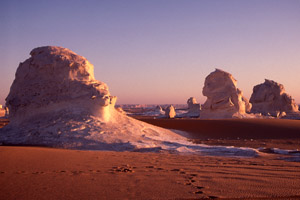
(The White Desert, 6th Oct, Egypt)
The night had not gone well as far as Chris was concerned. He had been vomiting for most of it and Alexis had to wake us up to borrow our re hydration salts at some point. Whilst they slowly packed up camp Anna and I wandered around the formations which were just about being lit by the golden rays of dawn. The further we went the more bizarre the formations got and the better the photographs got. The waves in the sand were so clear cut and so pristine that it was as if we were the only people ever to have found the place. A lot of the rocks had been weathered so that there profiles suggested faces. Heaven only knows what the inventive Chinese would have made at the place. Anyway I have included below a picture of a rock that looked uncannily like Alfred Hitchcock. We returned to the camp just as everyone was about ready to leave and after a short while we were piling back into the jeep and on our way back to Bahariya.
On the way back we stopped off at what was known locally as the "TV" station, a boosting station for microwave transmissions which I suspected served to keep Qasr-al Farafra in telephone contact with the outside world. Here we shared a frugal breakfast with the station guards, who were of course related to Sammy whilst Chris had a temporary respite from the motion of the jeep. After this we had quite a long drive back to Bahariya during which most of us dozed. Back in Bawiti our first priority was to get Chris sorted out. We took him to the local health clinic where he had some sort of nausea suppressant injected into him. This was the closest we ever got to using the sterile needles that we had carried all these months. However as it turned out the clinic was very well equipped and I suspect more sterile than our needles which had languished at the bottom of one of the rucksacks for twelve months. Following this Sammy flagged down a passing bus and managed to put Anna and I on it. We quickly said good bye to the others leaving them with the problem of what to do about the "extra" payment Sammy had managed to sign us up for. Then it was into the bus for a long, dusty and hot journey to Cairo.
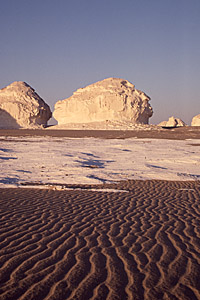
(The White Desert, 6th Oct, Egypt)
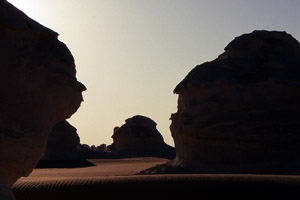
(The White Desert, 6th Oct, Egypt)
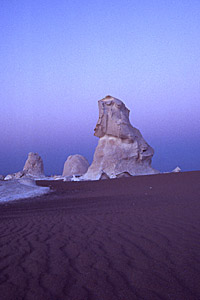
(The White Desert, 6th Oct, Egypt)
Epilogue: In case you are worried that we left four students to foot the bill for the "forty minutes" of off-roading have no fear. We ran into them a couple of days later in Cairo's Khan el-Kahlili Bazaar. Sammy had not made a big issue of it and everyone parted good friends.
Thursday, 19 August 1999
Cairo, Egypt
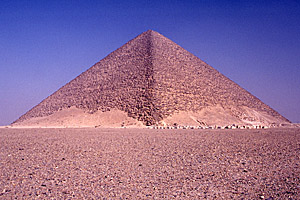
(Dahshur, Cairo, Egypt)
We had only four days of our trip left and so decided, having passed through it twice already, to finally settle in Cairo. We also decided to save the attractions of the Pyramids of Giza until the last day, hoping that the excitement built up whilst visiting less well known sites would make us immune to the hawkers that would no doubt swarm all over Giza.
Our first destination was the Pyramids of Dahshur. Surprisingly few tourists realise that the Pyramids at Giza are really only the tip of the iceberg, there are nearly 100 pyramids spread out over seventy kilometers along the Nile valley. However the pyramids at Giza and Dahshur represent the height of Egypt's power and in fact the majority of later pyramids were smaller and have not survived the ages so well having been built out of cheaper materials such as brick. Dahshur is about thirty kilometers south of central Cairo and was quite a challenging place to get to with a combination of trains and microbuses. The pyramid field was formerly in a military zone and only opened up to tourists in 1996 so there is no development there yet and that day we were the only people there which made the visit very peaceful. We entered the site and were immediately rewarded with our first close up view of a pyramid, the Red Pyramid of Sneferu , which at 101m is second only in size to the Great Pyramid of his son Khufu. As we approached the pyramid across a short expanse of desert we started to realise the scale of the pyramid. This is made all the more incredible by its age, Sneferu reigned from around 2613 to 2589 BC.
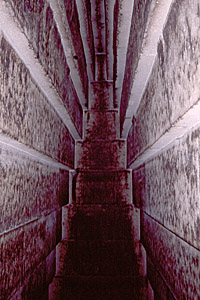
(Dahshur, Cairo, Egypt)
Luckily the pyramid was open so we were able to descend into the burial chambers. The descent was claustrophobic and the stairs very steep. There were three chambers, two long narrow gallery with corbelled ceilings and a smaller chamber at the top of the second gallery which we accessed by climbing a wooden staircase. Although it was dark we were not too worried about running into any mummies however as Sneferu was apparently not buried in this pyramid, for reasons unknown he built three pyramids and was most likely buried in the Bent Pyramid, our next destination, if at all.
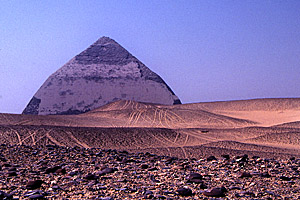
(Dahshur, Cairo, Egypt)
The Bent Pyramid is so called because it rises at a steep angle (54.3°) only to change to a much shallower angle three quarters of the way to the top. The reason for the change in angle as well as the often challenged fact that the neighbouring Red Pyramid was also built for Sneferu make these pyramids one of the great enigmas of Egyptology. The only viable theory is that Sneferu was also responsible for an earlier third pyramid at Maidum, south of Dahshur. The Maidum Pyramid started out as a stepped pyramid like the pyramids of the preceding dynasty at Saqqara but then was converted into a more regular pyramid by cladding it with limestone blocks. However the design had a flaw and the pyramid collapsed and its thought to have been this collapse which caused the radical rethink of the Bent Pyramid's angle. From these pyramids it is easy to see a clear evolution from the earlier dynasty's stepped pyramids at Saqqara, through the collapsed pyramid and bent pyramid to the near perfect design of the red pyramid. This evolution is the only proof that anyone needs to dismiss the theory that the pyramids were built by aliens because they were too far ahead of the technology of the people at that time.
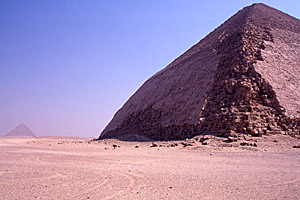
(Dahshur, Cairo, Egypt)
We walked over to the pyramid and as we neared the base we noticed that a soldier with an AK47 was standing guard. Rather alarmingly he rushed towards us and looked like he wanted to show us around. Considering the fact that we were the only humans for miles we decided to give him the benefit of the doubt and after walking around the pyramid with him acting as a silent guide gave him a tip. The walk around allowed us to see the other unique feature of the Bent Pyramid, its white limestone cladding. Originally all pyramids were encased in a higher grade of white limestone but this has been stripped off the majority of them to burn in kilns. However the steeper gradient of the Bent Pyramid made it dangerous to remove the cladding and thus is the only pyramid to have been preserved in almost all its former glory.
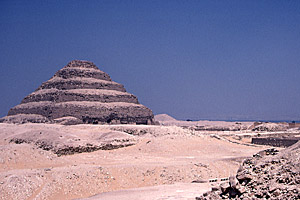
(Saqqara, Cairo, Egypt)
After leaving Dahshur we headed back towards Cairo and the Stepped Pyramid of Saqqara . These are much more regularly visited by tourists and have the added attraction of an extensive funerary complex. We approached the stepped pyramid along a limestone causeway which originally would have connected the complex with the Nile. In the middle of the funerary complex stood the 63m high, six level, stepped pyramid. The first pyramid, it was built by Imhotep the Chief Architect to the Pharaoh Djoser. We walked around the pyramid and explored the partially restored funerary complex. After this we spent the next couple of hours walking around the remainder of the site trying to visit the numerous Mastabas or decorated tombs scattered in the desert around but for some reason quite a lot of them seemed to be closed. When we finally came to leave we had quite a long wait in the village of Saqqara before a bus came and took us safely back to the civilisation of Cairo.
Friday, 20 August 1999
Cairo, Egypt
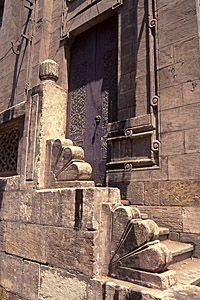
(Cairo, Egypt)
We decided to spend the next day walking around Cairo to get a feel for the city. We started out by taking the train out to Masr al-Qadima, or Old Cairo, the site of the town of Babylon in Egypt, where Mary, Joseph and Jesus were thought to have taken refuge from Herod, as well as the ruins of Fustat, the first Islamic settlement in Egypt, which we did not visit. Babylon is one of the centres for Copts and Christianity in Cairo and what currently remains of it is a small collection of houses, monasteries and churches encircled by fortified walls built by the Emperor Trajan in 130 AD. It has a very interesting atmosphere and probably gives the impression to tourists that the Copts are few in number and are besieged within this tiny quarter. This is far from the truth because in Egypt there are six million Copts spread throughout the country as well as 200,000 Christians of other denominations.
One of the most interesting places we visited within the walls was the Ben Ezra synagogue. Egypt at one point had a large community of 75,000 Jews whose presence dates back to the book of Exodus when Moses escaped enslavement by the Pharaohs and fled to the holy land. This community was tolerated along with the Copts throughout Egypt's Islamic period as they were all considered to be "people of the book". The decline started in 1956 with the Suez crises and continued as the war between Egypt and Israel escalated. Today fewer than two hundred remain and the Ben Ezra synagogue was only kept from ruin by the efforts of a Rabbi Cohen who overcharged tourists for postcards to pay for repairs. It was finally restored with money from the Jewish American Congress and now is a very interesting and peaceful place to look around.
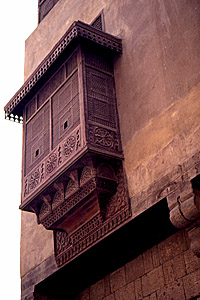
(Cairo, Egypt)
After that we walked through the streets of Cairo to the Mosque of Ibn Tulun. Here we were not interested in the Mosque but in a small mansion around the back of it called the Gayer-Anderson Museum. This was named after the English major who refurbished it and stocked it with his collection of Oriental artifacts. Most impressive is its reception hall which represents one of the finest surviving examples of Islamic decoration and was used as a set in the Bond film "The Spy who Loved Me". The room features a screened gallery which is accessed through a fake wall cupboard on the floor above and would have been used by women to spy on the activities of the men below.
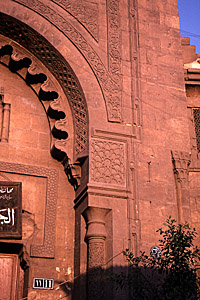
(Cairo, Egypt)
We then walked up to the huge Rifai Mosque and then through the Bab-al Wazir quarter to the Blue Mosque which despite undergoing restoration has some of the most interesting tiling in Cairo, turquoise sections of which give it its name. From the minaret of the Mosque we got an amazing view over old Cairo with its maze of small streets and shabby buildings punctuated by the domes and minarets of Mosques.
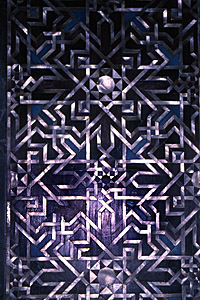
(Cairo, Egypt)
Leaving the Blue Mosque we continued wandering through the streets and into the Darb Al Ahmar quarter. As usual for the older parts of Cairo the streets were very narrow and we only saw the occasional car which had somehow crept its way through the people, animals and piles of goods that seemed to line every lane. After a lot of wandering we came to the Bab Zwayla, or Southern Gate, of the Fatamid city. The Fatamids ruled Egypt from 969-1171 AD and built a new capital Al-Qahira which now forms the heart of present day Cairo. Walking through the gates we came to a series of bazaars the first of which was the Spice Bazaar where we were surrounded by stalls and small shops selling an amazing array of spices. Here we started to shop for gifts, Anna buying some natural Henna and some dried hibiscus flowers to make karkady back in England.
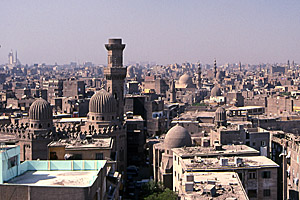
(Cairo, Egypt)
And that was pretty much it for the day. We wandered in and around the bazaars of the Khan el Khalili quarter, trying to find things worth buying, stopping to drink in the occasional cafe and photographing buildings in the light of the setting sun. I attempted to find a bronze Islamic hanging lamp, but in amongst the sphinxes and genuine papyruses all I could find was either too expensive to begin haggling over or in need of too much restoration, which seemed to be a common theme in the bazaar.
Saturday, 21 August 1999
Cairo, Egypt
I must be honest here, I have again not got much of a diary entry for this day. We spent it at the Egyptian Museum of Antiquities looking at all the objects and artifacts that have been uncovered at the various sites we had visited over the last few weeks. Memorable things are the obvious pieces such as the mask and treasure of Tutankhamen, as well as not so well known artifacts such as the Colossi of Arkhenatan with their rounded thighs and bellies suggestive of a hermaphrodite god Pharaoh.
Sunday, 22 August 1999
Cairo, Egypt
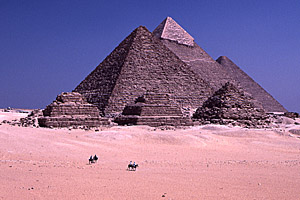
(Cairo, Egypt)
We had decided to save the best, and biggest, attraction to the last day, which was also Anna's birthday. It is hard to miss the pyramids of Giza and in fact we had seen them at a distance a couple of times from buses. However it was only as we got out of the local bus on the outskirts of the suburb of Nazlat al-Samman that we began to see the sheer scale of them. Their size is made even more incredible by their immense age, they are 4,500 years old. To put this into perspective consider that when the Greek historian Herodotus visited the Pyramids in 450 BC as many years separated him from their construction as separate us from the time of Herodotus, in other words even to the ancient Greeks they were considered ancient. Because of this antiquity and the fact that the pyramids bear no inscriptions (apart from the Great Pyramid which only has the name of Khufu carved in a very out of the way place) there has been a lot of speculation over the years as to their function, and to this day their has never been a universally accepted explanation as to how they were constructed.
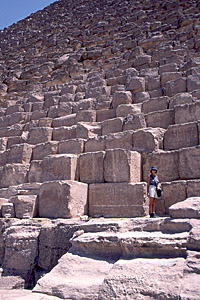
(Cairo, Egypt)
We bought our tickets and walked into the site and made straight for the Great Pyramid of Khufu . This we slowly circled trying to take in their size and cursing the fact that climbing them is now forbidden. We had already made a decision not to go inside it as we would have had to wait an incredible amount of time to be hemmed in with huge groups of sweaty tourists, plus we had a pretty good idea of the interior and atmosphere from the Red Pyramid, in which were entirely on our own.
On one side of the great pyramid we visited the Solar Barge Museum which houses a large boat, rebuilt from scraps of wood found buried alongside the pyramid, whose purpose is thought to have been to carry the Pharaoh through the underworld. Following this we walked around the various funerary complexes towards the Sphinx. The Sphinx again was quite unbelievable but what I found most interesting was that its body is disproportionately large for its head, a fact that is rarely clear from photographs.
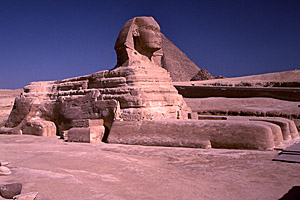
(Cairo, Egypt)
Of course one major problem of Giza that I have so far glossed over is that it is infested with hawkers and con merchants. We ourselves were stopped next to one of the Queen's pyramids claiming to be a ticket collector and asking to look at our tickets. We took one look at him, his shirt was a bit ropy and not tucked into his trousers whereas most Egyptian officials are spotless, decided he was not for real and walked off. We later discovered what he was up to, apparently they steal tickets this way and then re-sell them to people outside the gates. Near the Sphinx we even had to rescue a western woman who was being followed around by a very insistent "guide". She asked us to pretend to be her friends and on finding that she was not on her own the supposed guide gave up and went to prey on someone else.
To get away from this we decided to wander off into the desert around the Pyramids. Although we were accompanied most of the way by a horse riding "Bedouin" who was fairly insistently trying to sell us a horse ride somewhere, we finally managed to get some peace. We made for a small ridge where we sat down and looked at the pyramids from afar. The vantage point allowed me to take a photograph which again most people do not get to see, this time of the Giza plateau and pyramids with the grime of Cairo behind. It is easy to see why the photograph is not popular in guide books, it totally shatters the illusion that the Pyramids are buried deep in the desert.
That night we celebrated our last night and Anna's birthday with dinner at a slightly touristy but very nice Egyptian restaurant called Felfela. I again had Shakshouka, a dish which I had discovered in Siwa Oasis, which basically conists of spicy minced lamb and tomato topped with a partially cooked egg. Somebody attempted to interview us on camera for the Egyptian tourist board and in a rather pompous attempt to been alternative travellers we declined.
Monday, 23 August 1999
Cairo, Egypt
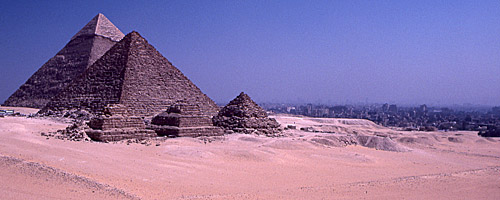
(Cairo, Egypt)
...and that was it. Our three month tour of the Middle East and our fifteen month world voyage was finally over. We took a plane back to Athens the immediately transferred to a plane back to England and home. We were very happy to see our flat and surprisingly eager to start working again. However it was not long before we started to miss the excitement of travelling and plan for our next, admittedly much shorter, trip.




